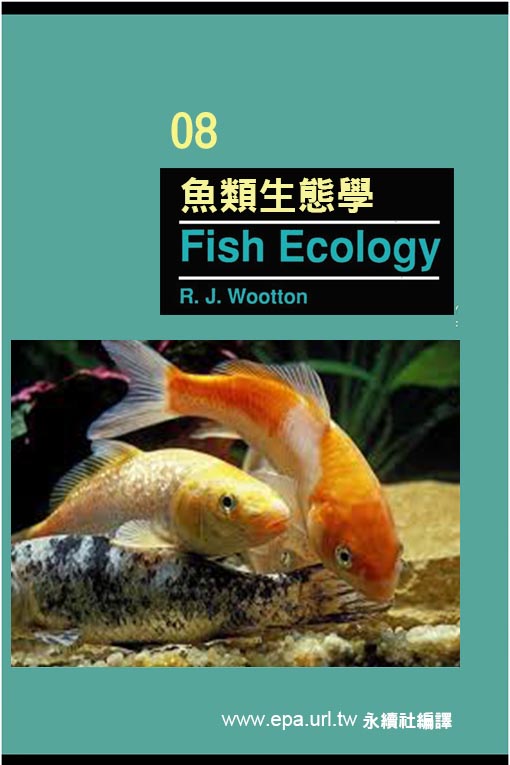
魚類生態學

魚類生態學
1. 水環境與魚分類
2. 魚類生理學
3. 環境條件對魚種分佈的影響
4. 生物因數與魚類群落結構
5. 移棲地與魚群行動
6. 攝食與生長
7.生活史和種群動態
8. 魚類應用生態學
8.1 概述
8.2 應用生態學問題分類
8.2.1 環境劣化
8.2.2 捕魚
8.2.3 水產養殖
8.3 河流應用魚類生態學
8.4.1 河流環境劣化
8.4.2 河岸漁業
8.4.3 河流養殖
8.4 湖泊魚類應用生態學
8.5.1 湖泊水庫環境劣化
8.5.2 湖泊漁業
8.5.3 湖泊養殖
8.5 海洋應用魚類生態學
8.6.1 海洋環境劣化
8.6.2 海洋漁業
8.6.3 海水養殖
應用生態學是研究人類活動對所關注物種的分佈和豐度的影響。在許多情況下,對魚類種群的影響是人類為達到其他目的而進行的活動的附帶副產品。在其他情況下,捕魚是最明顯的,其影響是人類將魚類種群作為一種資源加以開發的結果。
應用生態學中的關鍵問題是一個有時被奇怪地忽視的問題:人類活動對種群淨生殖率的影響是什麼,RQ?如果該值低於1,則總體下降;如果該值等於1,則總體在數值上保持穩定;如果該值大於1,則總體會增加。考利Caughley(1977)很好地表達了這一觀點。自然種群的管理涉及三個問題:(一)處理數量較少或正在減少的種群以提高其密度(保護);(二)利用種群從中獲取持續的產量(收穫);以及(iii)處理過於密集或增長率高得令人難以接受的種群,穩定或降低密度(害蟲防治)。
種群的平均淨生育率是其出生率和死亡率的函數。在大多數魚類種群 中,死亡率和繁殖力都與大小有關,因此生長率也是決定平均淨繁殖率的一個重要因素。因此,應用生態學中的一個問題可以被定義為確定人類活動對感興趣人群的 增長率、死亡率和繁殖力的影響,並確定通過改變這些速率中的一個或多個而產生影響的必要補救措施。在決定自然種群的死亡率、繁殖力和增長率時,有許多因素 涉及到這些因素。在水產養殖業中,這些複雜性中的一些是通過在簡化的環境中維持被開發的種群而忽略的。
除了少數例外,魚類應用生態學的大多數問題可以在三個標題下處理:(i)環境劣化的影響;(ii)捕魚的影響;和(iii)水產養殖的影響。
如果人類活動直接或間接造成的環境變化導致某些或全部魚類種群的淨繁殖率下降到1以下,從而導致魚類數量的減少,這一點是可以確定的。環境劣化有幾種形式。自然環境可能會發生有害的變化。魚所經歷的化學環境可能變得不利。生物體可能會被引入環境中,導致現有魚類物種的豐度下降。這些外來生物可以是其他魚類,或其他動物,包括魚類寄生蟲、植物或微生物病原體。
捕魚是一種有意的行為,儘管捕魚的動機可能有所不同。有些捕撈純粹是娛樂性的。自給自足和個體漁業為漁民及其家人和鄰居提供食物,威脅不大。商業漁業開發魚類種群主要是為了獲取經濟利益,改變了全球魚類生態。
如果漁民保留了捕魚的產量,則不可避免的結果是捕撈種群的數量豐 度和生物量減少。可持續漁業依賴於在自然死亡率、繁殖力和生長方面表現出密度依賴性變化的被開發種群,這些變化彌補了漁業的損失。一個簡單的漁業模型假 設,如果不捕撈,魚類種群將達到環境可長期維持的最大生物量。在這個最大平衡生物量Bmax下,出生率、增長率和死亡率正好相互平衡,因此生物量既不增加也不下降(圖8.1中的上曲線)。
如果種群減少到這個平衡水準以下,它就會做出反應,這樣出生和增 長的收益現在超過了死亡造成的損失,並且在沒有捕魚的情況下,種群將恢復到其最大的平衡生物量。然而,漁業也可以利用這一增長,保持其較低的開發生物量。 原則上,漁業的產量可以等於在沒有漁業的情況下,在被開發種群的生物量保持穩定的情況下所產生的增長。如果漁業獲得更大的產量,種群將下降,因為自然和漁 業死亡率超過自然出生率和增長率。如果漁業的產量較小,則由於自然死亡率和捕魚死亡率低於被開發種群的出生率和增長率,因此種群數量將增加。對於這個簡單 模型,可持續產量與種群生物量呈圓頂狀關係(圖8.1中的曲線較低)。可以定義一個最大可持續產量(MSY), 即在保持被開發種群生物量穩定的情況下,漁業在長期規模上所能獲得的最大產量。這種最大持續產量僅取決於被開發種群的生物學特性。它可能不符合在可持續的 基礎上使漁業利潤最大化的產量,即由於漁業的經濟性而產生的最大可持續經濟產量。這將取決於非生物量,包括捕魚成本和魚的市場價格(Pitcher和Hart, 1982年)。

圖8.1漁業產量的簡單模型。上圖顯示生物量新增到平衡生物量,B max。。從低豐度開始的未開發人口。下圖顯示了與現有生物量相關的永續產量,包括最大永續產量(MSY)下的生物量。
漁場產量的來源可以從E.S.Russell在20世紀30年代最初制定的一個簡單方程式中看出(Pitcher and Hart, 1982;Cushing, 1988):
B2=B1+(R+G)-(M+F)
式中,B2是第2季開始時種群的生物量,B1是第1季開始時的生物量,提前一個時間段(通常是一年);R是在第1到第2個時間段內招募到可捕撈規模的生物量;G是由於同期增長而增加的生物量;M是自然死亡損失的生物量,F是漁業所獲得的生物量。漁業經理的問題是選擇一個F值,在可持續的基礎上使產量最大化。
如果漁業管理者設定的F值過高,他們將面臨兩個問題。這是過度捕撈的增長和過度捕撈的招募。在設計漁業管理技術以減輕第一種情況方面取得了一些成功(Beverton和Holt, 1957年),但第二種方法已被證明更加棘手,仍然對許多漁業構成威脅。
過度捕撈發生在捕撈強度如此之高,以至於所有大型魚類都從種群中消失,漁業利用越來越小的魚類。因此,這些小魚的一些生長潛力在它們被捕獲之前沒有被意識到。防止過度捕撈的管理技術包括增加用於捕魚的漁網的網目尺寸,以使較小的魚類能夠逃脫,或降低捕魚強度,使至少一些魚類能夠存活足夠長的時間來發揮其生長潛力(Cushing, 1988)。
對過度捕撈的增長問題的分析常常假定,由於魚類的繁殖力如此之 高,無論捕撈種群的大小,都會有足夠數量的魚類被捕撈。對於許多魚類種群來說,這不是一個現實的假設。捕撈死亡率過高,在某些情況下,再加上不利的環境條 件,會使性成熟種群的數量減少,以致繁殖率不再足以彌補數量上的損失,種群數量減少。
為避免過度捕撈,漁業經理必須確保在種群中留下足夠的性成熟魚類,以維持招募。這意味著管理者必須能夠預測從一個給定數量的性成熟的魚將招募什麼。不幸的是,對於大多數魚類種群來說,要做出可靠的預測是困難的,甚至是不可能的(Rothschild, 1986)。這是因為,在大多數已開發的魚類種群中,決定魚類招募數量的因素在魚類生命史的早期階段起作用,而這是魚類生命史中最難定量研究的時期。
雖然現代的商業捕魚船隊使用先進的技術,如漁船、漁具和探測魚類的設備,但它們仍然是捕獵者。它們的獵物數量隨環境條件的變化而變化。水產養殖系統試圖通過在不同程度上受控的條件下飼養魚類,儘量減少環境波動的影響。以卵或幼魚的形式出現的種子被帶到水產養殖系統中,在那裡生長到適合收穫的大小(圖8.2)。水產養殖業是與農業相對應的水產養殖業(Reay, 1979年),與農業一樣,水產養殖業在不同的技術水準上都在追求。
在最簡單、廣泛的水產養殖中,幼魚被放養在池塘或圍欄中,並在一段時間後依靠天然食物進行捕撈。天然食物可通過向池塘施放飼料、肥料來補充,有機廢物包括動物和人類糞便、草屑和其他蔬菜廢物。在中國南方的一些地區,池塘邊種著桑樹,以養活蠶。蟲子、蛹繭和枯枝落葉落在池塘裡,使水肥沃,或被池塘裡的魚吃掉。在許多發達國家,大部分或全部的水產養殖都是集約化的,魚通常以團塊的形 式餵養,例如鮭魚養殖場使用的顆粒。在這些集約化系統中,糧食通常是農民的主要成本。工業化漁業通常是以人工魚飼料為基礎的。這兩種剝削形式之間有著密切 的聯繫。從狩獵活動中獲得的高品質魚類蛋白質可用於生產與養殖魚類同等高品質的蛋白質。理由是消費者願意為養殖的魚和捕獲的魚支付的價格差異。
許多水產養殖系統都是單一養殖,在整個生長期內物種保持分離(Bardach et a/, 1972;Shepherd and Bromage, 1988)。然而,在中國,多個物種共同生長的混養技術是一項重要的技術,目前已被印度和以色列等其他國家採用。多元文化在中國有著悠久的歷史,可以追溯到西元1000年以前。它的技術反映了對生態學原理的深刻理解,儘管它早於生態學作為一門科學的發展(Bardach等人, 1972)。它認識到池塘提供了一個三維的棲息地。因此,把池塘當作一塊田地來對待,只種一種作物很可能是浪費。一個池塘也可以提供幾種不同類型的魚食。只飼養單一物種會導致一些潛在的食物被忽視或使用不足。在中國的混養中,池塘裡飼養著幾種鯉魚。物種的選擇確保了廣泛的食物使用(圖8.3)。鰱魚生活在半水中,以浮游植物為食。鱅魚也生活在半水中,但以浮游動物為食。草魚(Ctenopharyngodon idellus)以大型植被為食,而青魚(mylpharyngodon piceus)以底棲軟體動物為食。雜食性鯉魚也可能包括在這個集合中,物種組成的變化是常見的。池塘通過添加有機肥料來施肥,而草魚則以草和蔬菜插條為食。
最重要的養殖魚類包括鯉魚、吳郭魚、鮭魚和鱒魚(鮭魚科)、鰻魚、鯰魚,以及東南亞沿海地區的乳魚(鮭魚科)。水產養殖年產量約占世界魚類總產量的10%。商業漁業的產量不太可能增加太多,但水產養殖的產量仍有很大的潛力,特別是低技術系統。
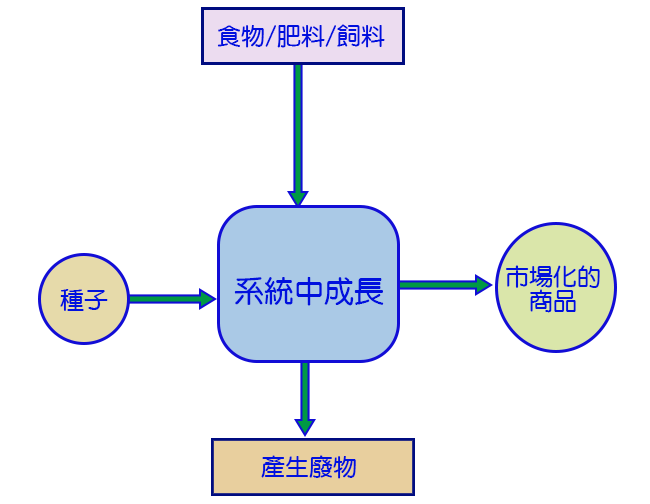
圖8.2 水產養殖系統原理。Reay (1979).

圖8.3 中國湖塘多種養殖的卡通圖:(a)以植物為食的草魚;(b)以浮游植物為食的鰱魚;(c)以浮游動物為食的鱅魚;(d)以蝸牛為食的青魚;(e)以底棲無脊椎動物為食的鯉魚。
人類利用河流的方式可以降低河流魚類的生存環境。然而,河流環境的惡化也可能是由與河流沒有直接關係的人類活動引起的。
8.3.1.1 物理結構
它們被用來改變河流的流態,以達到防洪、航運和發電的目的。防洪工程經常簡化河流結構,洪水在一個明確的河床內流向下游。與這種簡化相關的棲息地異質性的喪失可能導致魚類群落物種多樣性的下降。防洪計畫經常破壞回水區和其他淨水區,這些地區是河魚重要的產卵區和育雛區。重要的是,防洪方案的設計應考慮到動物的棲息地要求。修改後的環境必須為物種生命史的每個階段提供條件,以提供個體發生的連續性。
水壩可作為防洪計畫的一部分,以改善航運和水電計畫。一個單一的水壩可以組合多種功能。水壩的存在會阻礙河魚的活動,從而對它們產生直接影響。大壩還將改變河流棲息地和水流狀況。
水壩阻礙了上游產卵的遷徙,並能將種群與正常產卵地隔離開來。為了緩解這種情況,已經開發了幾種技術。有些水壩旁邊建有魚梯(魚道)。這提供了一條過道,魚可以通過這條魚道越過水壩。問題是要確保魚能找到梯子的入口。梯子的一個改進是提魚器,其中使魚越過水壩的能量是由人而不是魚提供的。在一些水壩裡,魚是用水車從大壩下面運到上面的。在北美和歐洲,所有這些技術都被用來讓溯河產卵的鮭魚到達產卵地。此外,或作為替代方案,在大壩下游修建魚類孵化場,因此,由於無法進入產卵場而導致的自然補充減少,可通過孵化場養殖的魚類進行補償。性成熟的魚在水壩下游被捕獲,並在孵化場產卵。這些幼魚也被放生在大壩下游。這項技術正在中國中部的宜昌使用。在這裡,橫跨長江的大壩阻斷了鱘魚產卵的上游遷徙。
水壩也會導致洄游下游的幼魚死亡。當魚被帶過溢洪道,通過排水隧道或水力發電系統的渦輪機時,它們會被殺死或嚴重損傷。
此外,大壩的修建在其後面形成了一個湖泊般的環境,並可能在其正下方形成一個湍急的尾水區域(Neilsen等人, 1986)。這些變化將導致魚類組合的組成發生變化。當西非的沃爾特河被築壩形成沃爾特湖時,以底為食的mormyrids數量減少,但食草動物cichllids和遠海clupeids卻大量增加(Lowe-McConnell, 1987)。在北美俄亥俄河和密西西比河中,與船閘一起建造的水壩底部的尾水提供了湍急、富氧的水和適合沙礫產卵魚類(包括walleye)的基質(Neilson等人, 1986年)。
8.3.1.2 工廠的水提取。
從河流中提取的水用於發電廠和其他工業生產的冷卻。使用過的水通常會比未使用的水高出一些度,從而引起河水的局部變暖。這種提取常常給魚類種群帶來新的死亡原因。提取出來的水會通過過濾網過濾掉會破壞植物的物質,但這些濾網也會捕捉到用冷卻水吸入的魚(Wheeler, 1979)。
由於同一群落中的物種具有不同的熱耐受性,釋放回河流中的熱水的影響會有所不同。對於廣溫魚類(包括許多鯉科魚類),加熱的水可以提高生長速度(Alabaster和Lloyd, 1982年);但是,冷水魚,包括鮭魚,可能被排除在加熱水中。一股巨大的熱水體可能成為此類物種向上游遷徙的屏障。熱水區也可以是低氧區。
8.3.1.3 採礦、採石和林業
這些活動會導致河流的物理變化,從而對魚類種群產生影響。採礦、採石和洗煤等相關活動會釋放大量細固體。當它們定居下來時,它們會扼殺鮭魚和其他礫石產卵物種的產卵地。高濃度的懸浮物會堵塞魚的鰓,並最終導致死亡。造林用地的整備也會將細顆粒固體引入水體。從長遠來看,森林可以通過減緩水溫和流速的變化而產生有益的效果。然而,也有證據表明,針葉林可以通過清除大氣中富含酸的顆粒和液滴來擴大酸性降水對溪流和河流的影響(Edwards等人, 1989年)。
8.3.1.4 污染
有毒物質可能是故意或無意中進入河流的。與大型湖泊或海洋相比,河流中的水量相對較小,這意味著這些排放物的不利影響在河流中通常更快、更顯著。可以區分兩種形式的污染。有些污染物由於其毒性而對魚類產生直接的不利影響。其中包括重金屬,如鎘、鉛和鋅,其他無機化合物包括氯、氰化物和氨,以及有機化合物,如苯酚、 殺蟲劑和除草劑。另一種形式的污染是由有機廢物造成的,包括農家庭院廢物和生活污水。細菌對這些廢物的分解會消耗掉水中的氧氣。魚不是被廢物本身殺死的, 而是通過去氧作用殺死的。污染可能是偶發的,也可能是長期的慢性污染。由於河流下游水流的沖刷作用,在間歇性污染之後,水質有望恢復。溪流魚類迅速重新聚 集乾涸地區的能力表明,隨著條件的改善,魚類區系可以相對迅速地恢復。
8.3.1.5 酸性沉澱
在過去20年裡,人們認識到大規模工業化帶來的一種慢性污染。發電站燃燒富硫礦物燃料所產生的硫氧化物和車輛排放物中的氮氧化物導致了酸沉降(亞當斯和佩奇, 1985年)。在大氣中,硫和氮的氧化物轉化為硫酸和白介素等酸!*在雨雪中沉積的ic酸。在土壤和下伏岩石含有鈣的地區,酸性降水被中和。在岩石和土壤缺鈣的地區,流入溪流和河流的徑流是酸性的。對溪流和河流的影響是增加其氫離子濃度(降低pH值)和增加有毒金屬(包括鋁)的動員。
在斯堪地那維亞半島、蘇格蘭、威爾士、加拿大東部和美國東北部,河流和湖泊魚類種群的減少或減少與酸性降水引起的水體酸度和金屬含量增加有關。實驗研究表明,低pH和高無機鋁濃度對魚類的生存和生理性能有不利影響。不幸的是,很少有研究確定pH值和金屬濃度的相關變化,在這種情況下,魚類種群的平均淨繁殖率低於臨界值。一個例外是薩德勒(1983)的一項研究,他使用褐鱒 魚的種群動態模型來定義挪威南部酸化水域的種群效應。這些模型綜合了污染物對生存、生長和繁殖成功的影響。在長期污染水準下定義淨生殖率的模型可以用來定 義間歇性污染的潛在額外影響。超過長期水準的河流會發生間歇性酸化,特別是在春季,當河流集水區的積雪融化時。融水可能是高酸性的。
Welcomme(1985)認 為,與湖泊或海洋漁業相比,河流漁業具有空間擴散性、季節性和多樣性的特點。這種擴散現象的出現是因為河流的寬度有限,這意味著任何一個登陸點的可開採水 域太小,無法支持主要的捕獲、加工和銷售活動。因此,河流漁業通常位於沿河分佈的一系列小定居點內,漁業是勞動密集型和手工型的。
河流漁業多種多樣。在一個極端,漁場可能是純粹的娛樂活動,魚被捕獲後被送回河中。在英國,休閒釣魚的參與者比其他任何運動都要多。在另一個極端,可能有一個發達的商業漁業。在這兩者之間,有一年中進行有限時間的自給漁業或全職個體漁業,其中漁民可以自己遷徙以利用魚的移動(Welcomme, 1985年)。
捕撈方法和漁獲物的種類組成也各不相同。除了刺網、圍網、拖網和誘餌鉤(也用於湖泊和海洋漁業)外,河流漁業還使用各種誘捕器。當洪水退去時,這些裝置可用於誘捕魚類,或在魚類在河流中上下游移動時捕獲魚類(圖8.4)。在一些河流中,漁業以一個或幾個物種為目標。北美和歐亞大陸以鮭魚為目標的漁業也是如此,但在大多數河流系統中,捕獲的魚含有許多不同種類的魚。在河流漁業的發展過程中,大魚種在漁獲量中所占比例有下降的趨勢,因此小體魚變得更為重要(Welcomme, 1979, 1985)。
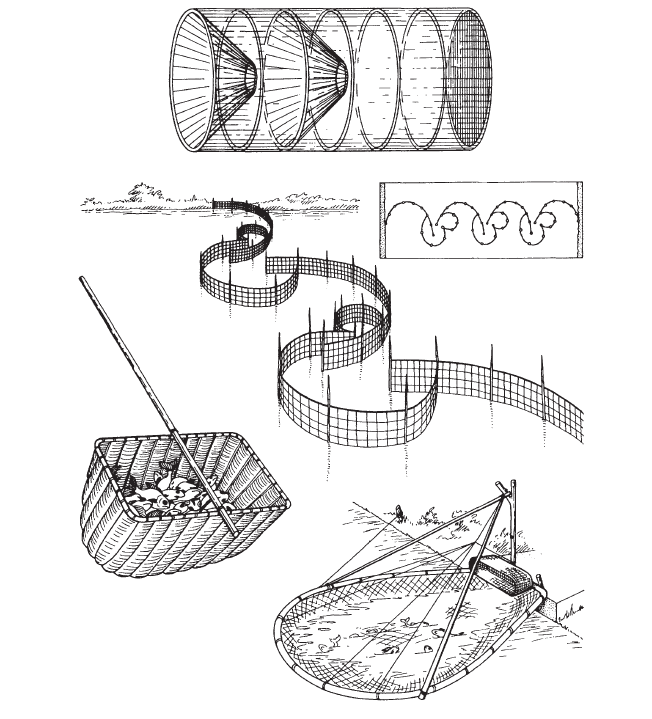
圖8.4 河流漁業中使用的陷阱和漁網示例 Welcomme (1985).
許多水產養殖系統建在河邊,以利用流動的水。水通過養魚場從河中 分流,然後返回農場下游的河流。這種安排使通過農場抽水的費用降到最低。一個缺點是,廢物可能會從農場帶入河流,造成一些去氧作用。疾病可能在養殖魚類和 野生魚類種群之間傳播。養殖場飼養的魚類可能是不同的物種,也可能是來自不同遺傳株的河裡野生魚。從養殖場逃出來的魚可能都是外來種。
在養殖物種中,狹溫鮭魚對水質的要求最高。在12℃的水中生產1噸200克虹鱒魚需要11.1 L/sec的水流(Shepherd和Bromage, 1988年)。愛達荷州的一個鱒魚養殖場在15°C時使用4000 L/sec的泉水,每年生產600 000 kg(Bardach等人, 1972年)。
與河流相比,湖泊中的水滯留時間較長,這意味著沖刷作用減弱,因此進入湖泊的污染物很可能會滯留在湖泊系統中。
8.4.1.1 富營養化
湖泊受到許多與河流相同形式的環境劣化的影響,例如無機和有機化學品、污水和熱水。此外,湖泊受養殖富營養化過程的影響可能比流水更大。富營養化是指水體富含植物營養物質,特別是磷和氮。這導致藻類和大型植物的生長增加,並可導致可見的浮游生物水華和藻墊(Meybeck等人, 1989年)。這種植物物質的分解會消耗水中的氧氣,並釋放出有害物質,包括毒素和硫化氫。當植物營養物質來源於人類活動時,就會發生文化富營養化。農用地大量使用氮肥和磷肥,以及國內和工業上使用含磷酸鹽的洗滌劑,都是造成富營養化的原因。
北美洲五大湖之一的伊利湖就是富營養化的一個引人注目的例子。在20世紀60年代,養殖富營養化導致部分湖泊(中央盆地的下湖水)在夏季完全缺氧。湖中的一個重要部分對湖中的魚類來說是不可利用的。由於過度捕撈以及湖岸城市和農業開發進入湖泊的其他污染物(Christie, 1974;Meybeck等人, 1989),這些污染物已經受到了壓力。對水質和魚類種群的影響如此之大,以至於伊利湖的兩個鄰國、加拿大和美國都推出了一項廢物處理方案,以有效降低進入伊利湖的磷酸鹽含量。
8.4.1.2 湖泊酸化
具有基岩和土壤的流域中的湖泊無法緩衝酸性流入,其pH值會下降。一項大規模的實驗研究表明,這種慢性酸化會對湖泊魚類產生重大影響(Schindler等人, 1985年;Mills等人, 1987年)。安大略省西北部的223個湖用硫酸處理,因此在1976年至1983年期間,其pH值從7.64降至6.13。在此期間,對幾種物種的種群密度和繁殖情況進行了監測。在過去幾年的酸化過程中,該物種遭受了繁殖招募失敗。對於一些物種,可以估計出發生故障的臨界pH值:湖鱒魚,6.59;白吸盤魚,6.02;肥頭小魚,6.93;珍珠鱸魚,6.09。
8.4.1.3 外來物種引進
目前的證據表明,環境劣化的一種形式是外來物種的引入,對湖泊魚類的影響比對河流魚類的影響更大。美洲五大湖經歷了幾次這樣的引入,加上大量捕撈和環境劣化的影響,促使魚類區系組成發生重大變化(Smith, 1968;Christie, 1974;Christie等人, 1987)。
直到19世紀,尼亞加拉大瀑布形成了安大略湖和其他五大湖之間魚類活動的屏障。隨著韋蘭運河的修建和隨後的航行改進,一條連接安大略湖和伊利湖的走廊被建立起來。這使得五大湖區面臨聖羅倫斯河乃至西大西洋魚類區系的入侵。重大的入侵發生得很慢。19世紀30年代,人們在安大略湖發現了海洋七鰓鰻,但直到1921年伊利湖、1932年休倫湖和1936年密歇根湖才有記錄。然而,一旦建立,這種外寄生無核生物的影響是災難性的。湖鱒魚是五大湖區最主要的魚類捕食者之一,從19世紀起就一直支持商業漁業。直到20世紀40年代,鮭魚和其他鮭科魚類在總漁獲量中所占比例很高,後來鱒魚漁業崩潰(圖8.5)。造成這種崩潰的原因可能是七鰓鰻對鱒魚種群的影響,鮭魚種群已經受到漁業的壓力,而在這種情況下,捕撈總量一直在增加。尤其是白鮭魚和其他大魚的注意力轉向了大魚。這些物種中體型較大的物種數量也在減少,有些物種甚至滅絕。
七鰓鰻對鱒魚、鱸魚和較大的水母的捕食作用是降低這些魚類對小型浮游物種的捕食強度。它們太小,不容易受到七鰓鰻的捕食。
在這一點上,第二個入侵者變得突出。灰西鯡魚曾在安大略湖出現過,但從20世紀30年 代開始,只在其他五大湖有記錄。密西根州湖泊中的浮游鱒魚和浮游鱒魚的數量在崩塌之後大大增加。它的存在更為明顯,因為它有遭受週期性的大規模死亡的傾 向,湖灘上到處都是死魚和腐爛的魚。湖中最小的水母,浮游動物的浮游水母,也隨著鱒魚和大型水母數量的減少而大量增加。作為增加湖鱒魚和其他食肉性魚類密度的政策的一部分,一項七鰓鰻控制計畫於1950年代開始實施,一種化學物質被用來殺死七鰓鰻繁殖的入口溪流中的梭魚幼體。到20世紀60年代末,七鰓鰻的密度已經下降到峰值數量的10-15%。
儘管美洲五大湖的變化並不僅僅是由於七鰓鰻和灰西鯡魚入侵的結果(對具有商業價值的鱒魚的密集捕撈壓力也起了作用),但它們說明了外來物種可以改變湖泊魚類區系的方式。
另外兩個例子強調了這一點。尼羅河鱸魚引入維多利亞湖導致了當地慈鯛科種群的崩潰,其中許多種類是維多利亞湖特有的(佩恩, 1987年;阿奇亨, 1990年)。捕食者Cichla ocellaris被引入巴拿馬加頓湖,導致本地物種的多樣性和豐度大幅度減少(Zaret和Paine, 1973年)。儘管外來物種已經被引入河流,例如,一種食肉的鱸魚,zander(Stizostedion lucioperca)已經從歐洲大陸引入英格蘭的河流中,但其影響似乎還沒有湖上的例子那樣災難性。這是否代表了湖泊和河流易受入侵的真正區別,還是僅僅是已詳細描述的例子的一個偽製品,還有待於發現。
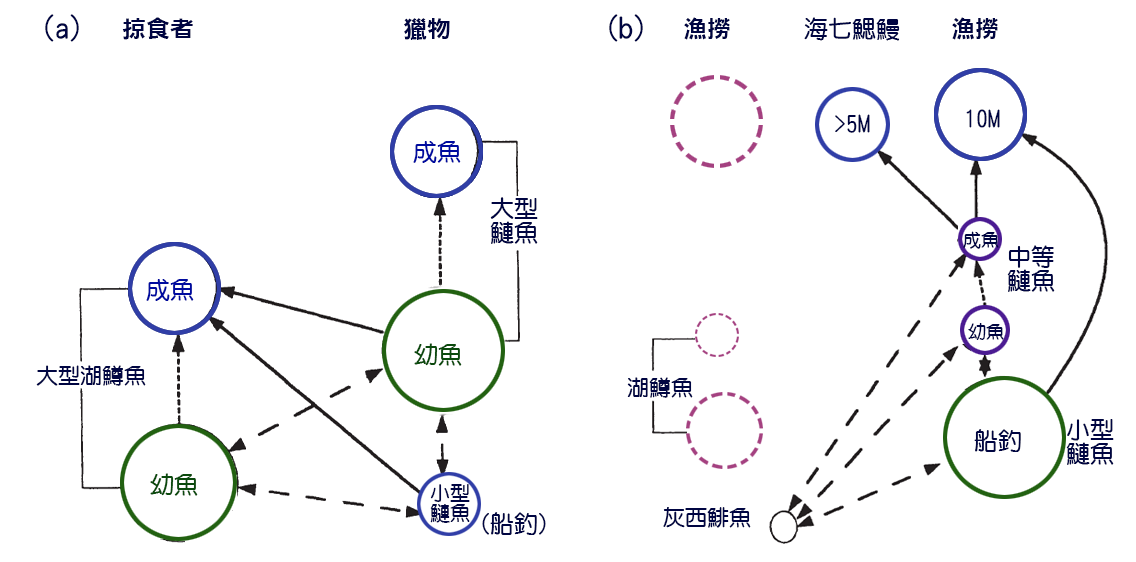
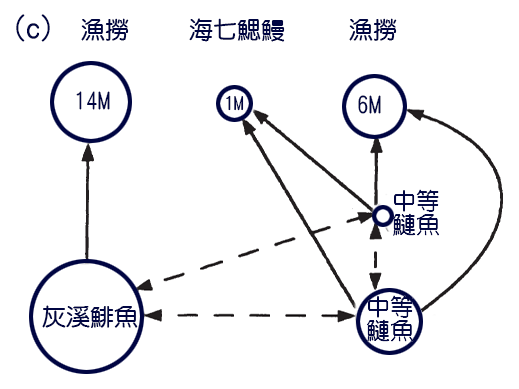
圖8.5 由於過度捕撈和七鰓鰻的影響,美國五大湖魚類聚集和漁業的變化。Smith(1968)。(a)未開始撈捕時;(b)1950年代中期;(c)1960年代中期。
在許多發達國家,湖泊支持休閒漁業,但較大的湖泊也可以支援重要的食物漁業。北美五大湖是休閒和商業漁業並存的一個例子。在1900-1970年期間,安大略湖、休倫湖、密歇根湖和蘇必利爾湖的年捕獲量為24.4至39.8 x 106 kg。由於上述原因,鮭魚類所占比例從近80%下降到不到40%(Christie, 1974)。然而,為了通過增加魚類捕食者的密度來控制白鮭和白鮭的數量,已經採取了一項在湖泊中飼養本地湖鱒魚和外來太平洋鮭魚(Oncorhynchus spp.)的政策。這些鮭魚對漁民也很有吸引力。在五大湖淡水中建立溯河產卵的太平洋鮭魚產卵路線是一些硬骨魚類適應性的一個顯著例子。
在熱帶湖泊中,自給自足和商業捕魚可能繼續並行不悖。特別是在非洲,湖泊漁業是動物蛋白質的重要來源。從1968年到198年期間,記錄在案的維多利亞湖水域的漁獲量從16357公噸增加到125071公噸(Acheing 1990年)。這種捕撈量的增加伴隨著漁獲量構成的重大變化,因為食魚的尼羅河鱸魚在總漁獲量中所占的比例越來越大。早些時候,維多利亞漁場曾被兩個土著慈鯛科魚類控制,即Oreochromis esculentus和ま。易變性。然而,過度捕撈,在一定程度上是由於採用了網眼尺寸減小的刺網,導致了這種漁業的消亡。
在北美五大湖區,捕魚方法與公海捕魚方法相似,包括刺網、拖網和塞納網。技術改進大大提高了這些方法的效率,因此增加了過度捕撈的增長和招募的危險。在美國大湖區漁業中,用尼龍代替棉布和亞麻布作為刺網材料,使捕魚強度增加了三倍(Christie, 1974年)。總捕魚量沒有補償性減少。
利用湖泊環境的最常見的水產養殖技術是網箱養殖(Beveridge, 1987)。魚被關在懸掛在湖中的籠子裡(圖8.6)。這種方法依賴於水的自然運動,將含氧良好的水帶入網箱,並從魚身上帶走被廢物污染的水。在廣泛的網箱養殖中,這些魚使用湖中產生的天然食物。在密集的網箱養殖中,這些魚被喂以顆粒形式的人工食物。如果這些食物最終都不會被野生動物吃掉,它們就會從籠子的底部沉澱下來。
不允許網箱魚產生的廢棄物造成湖水水質下降,不適合野生魚類甚至網箱魚。網箱魚的廢棄食物和廢物會導致養殖富營養化(圖8.7)。在波蘭的一些湖泊中,虹鱒的網箱養殖導致了本地白魚的消失(Penczak等人, 1982年)。
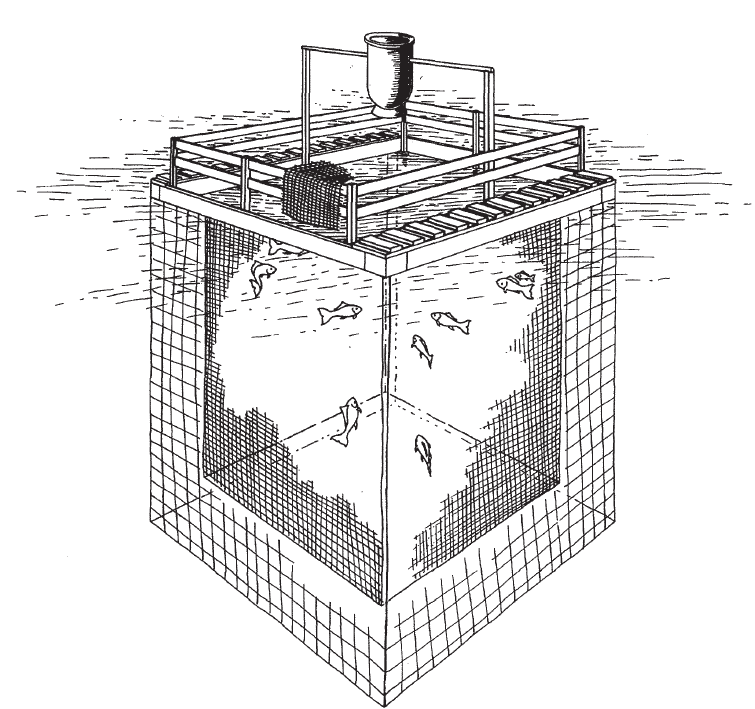
圖8.6 湖泊及灌溉水庫養殖箱籠
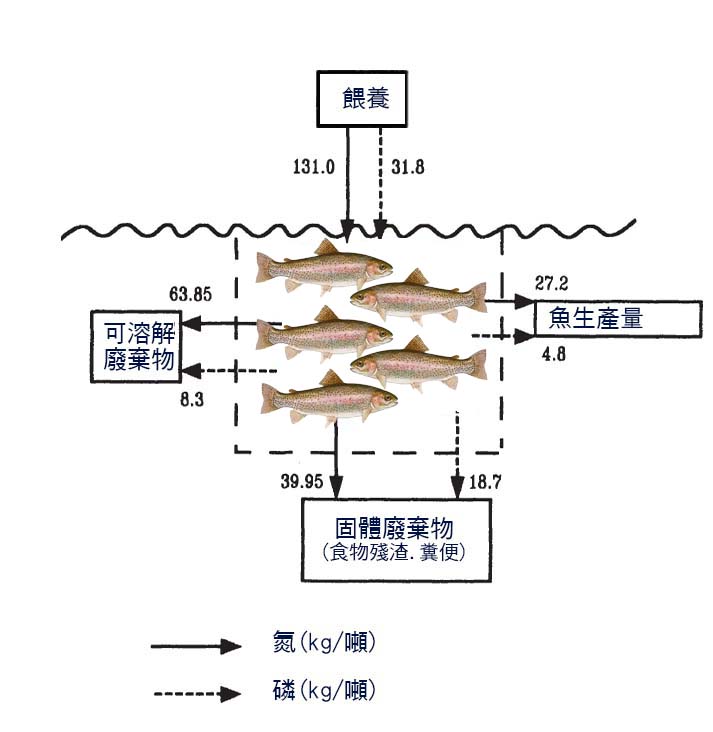
圖8.7 虹鱒網箱養殖,氮、磷的投入和產出(每噸魚產量kg)
在本世紀的大部分時間裡,海洋被視為一個取之不盡的廢物庫,實際上是魚類和可食用無脊椎動物形式的高品質蛋白質的取之不盡的來源。由於海洋的水量如此之大,它們可能會受到嚴重污染或過度捕撈,這似乎是不可想像的。現在有證據表明污染嚴重,儘管污染通常發生在局部地區,估計表明世界海洋漁業正在接近飽和,如果還沒有達到飽和的話。
8.5.1.1 物理環境劣化
海灣、河口、紅樹林沼澤和其他淺海、近岸地貌通 常是海魚的繁殖區。它們也是人類為了防洪、水產養殖業、開墾農業或建築用地,以及隨著對可再生能源的探索加劇,利用潮汐流建造水力發電攔河壩的目的,經常 故意改變這些特徵。鑒於早期生命史階段的死亡率對隨後的成體豐度的作用存在不確定性,保育區的破壞在多大程度上對海洋物種的種群豐度有影響,尚待確定。
在以北海為例的局部地區,廣泛的沙礫疏浚使傳統的底棲產卵場(如鯡魚)面臨危險(克拉克, 1989)。產卵地也可能因傾倒陸地污水處理或港口和水道疏浚工程產生的淤泥而面臨危險。到目前為止,幾乎沒有證據表明這種行動與魚類數量的下降有關。
缺乏證據表明,這一點也與海洋環境的化學劣化有關,有時可以被忽視。儘管海洋代表著大量的水,但通常較小的區域對魚類種群的繁殖成功至關重要,因為它們是產卵、育兒或餵養區域。
8.5.1.2 化學環境劣化
多年來,人們一直認為,任何釋放到海裡的有毒物質都會被稀釋到不會對魚類種群產生有害影響。近年來,核工業產生的低水準放射性廢物和大型油輪或海上油田排放的石油增加了包括重金屬和有機廢物在內的污染物。
與高度工業化國家相鄰的淺海不斷吸收從河流和海岸線湧入並從大氣 中進入的污染物並使其無害化的能力有限。波羅的海基本上是封閉的,只有一個小出口通向北海。它的南部海岸線種群稠密,工業化程度高,而在北部海岸線有主要 的造紙和木漿工業。有機物和磷酸鹽的輸入導致波羅的海部分富營養化。儘管食肉魚類的相對重要性有所降低,但缺乏對近海漁業有害影響的證據(Clark, 1989)。
生物過程可以逆轉海洋的稀釋作用。許多有機體積累了一些污染物,因此體內的濃度比環境中的濃度高。這種生物積累過程被生物放大過程放大。這導致處於食物鏈頂端的動物以已經含有相對較高水準污染物的生物體為食,從而積累更高的水準。
一些合成的有機化合物,如殺蟲劑DDT和工業上使用的多氯聯苯(PCBs)幾乎不溶於水,但可溶於脂類;因此,它們積累在脂肪體和其他脂肪含量較高的器官中。在魚類中,其濃度可能是海水中的100至10000倍。脂肪儲備的局限性可能意味著,當魚類營養不足並正在調動其脂肪儲備時,有機污染物變得更加危險。
汞是一種有毒的重金屬,在食物鏈中處於高位的魚類體內積累,如遠海鮪魚和底棲鱈魚。不鼓勵食用較老的鮪魚,因為它們肌肉中的汞含量高達5.9ppm。海洋魚類的典型值約為0.15 ppm(Johnston, 1976;Clark, 1989)。汞中毒是由海洋污染直接導致人類死亡的少數幾個明顯例子之一。日本近海漁業社區至少有兩次因食用受污染的魚而導致汞中毒死亡。這些魚受到污染是因為重點工業正在向近海水域排放汞廢物。在受影響的地點之一Minimata,浮游生物含汞5 ppm,魚類含汞10-55 ppm。食用魚可接受的含量約為1ppm。
儘管這些焦點事件清楚地表明瞭海洋污染可能產生的巨大影響,但海洋魚類種群豐度的自然變異性使人們很難發現更細微的影響。
這就使得更重要的是進行對適應度組成部分—生長、死亡率和繁殖力—的影響的實驗研究,並根據對平均淨生殖率的影響來解釋。
水產養殖業的貢獻正在增加,但海洋漁業仍占全球魚類捕獲量的大部分(圖8.8)。在總產量約8500萬噸(包括無脊椎動物)中,水產養殖業約占12%(5%有鰭魚)(Shepherd和Bromage, 1988年)。
根據海洋學特徵,海洋漁業可分為沿海、上升流和海洋三種基本類型。沿海漁業開發的大陸棚區深度為150-200米。使用的主要捕魚技術有拖網、圍網、刺網和長線釣(圖8.9)。所捕獲的魚包括遠海梭子魚和長鰭鯛、底棲圓魚(包括鱈魚)和底棲比目魚(圖8.10)。在溫帶地區,漁業通常集中在一個或幾個物種上,而在泰國灣等熱帶地區的陸棚漁業中,漁業需要許多物種。上升流漁業利用集中的中上層魚類,尤其是棒狀體和短鰭類。這與密集的浮游生物種群有關,在秘魯和加利福尼亞海岸等大陸邊緣,涼爽、營養豐富的水向上湧。海洋漁業利用大型遠海食肉動物,尤其是鮪魚。他們依靠長線、流網或圍網。
儘管仍有許多自給自足和個體化的海洋漁業,但商業工業化漁業占主 導地位。他們使用先進的船隻、漁具和定位魚的方法。這項技術對魚類資源的長期保護有兩大缺點。首先,設備的高資本成本給漁民帶來了壓力,要求他們維持漁獲 量以滿足這些成本。第二,這些方法允許魚類種群被開發,即使它們的絕對豐度很低。例如群聚的魚群組成巡游。即使在種群密度較低的情況下,魚群巡游也會形成高密度的局部區域。利用聲納技術探測魚群和圍網圍住魚群,可以維持漁場。
對三個漁業的簡要敘述將說明那些試圖按照合理原則開發和管理漁業的人可能面臨的一些問題。河流漁業與湖泊漁業是並行的。
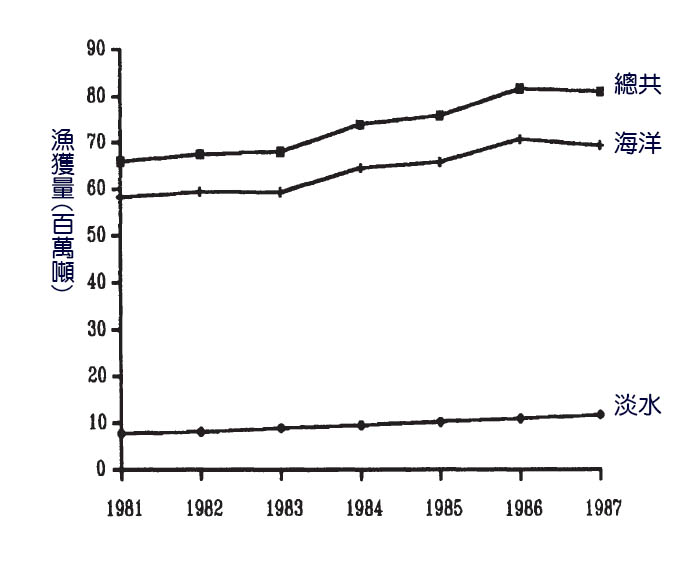
圖8.8 1981年至1987年世界魚類捕獲量(數值包括漁業和水產養殖的產量)。FAO Fishery Statistics, 1987.
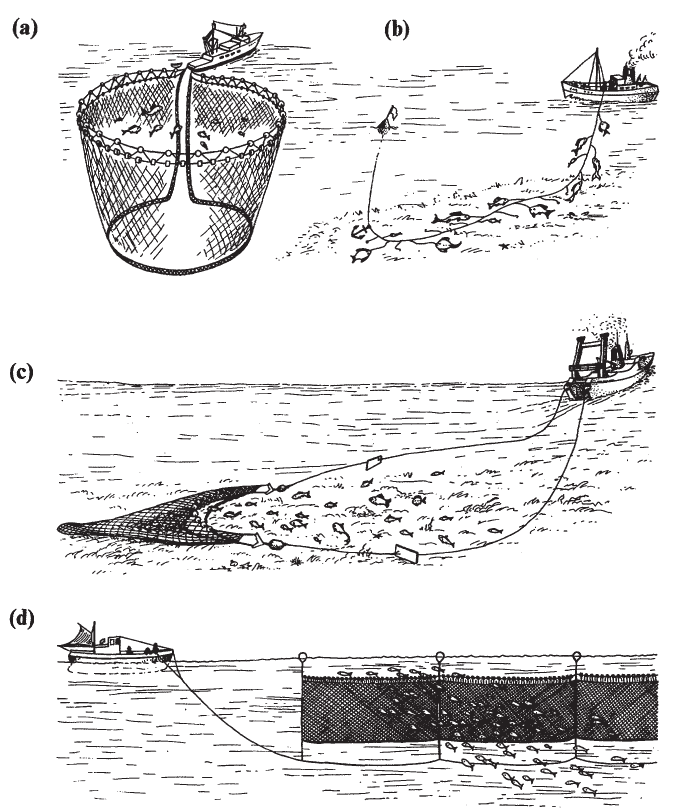
圖8.9 捕漁業中使用的方法:(a)圍網;(b)長線釣;(c)拖網捕撈;(d)刺網(或流網)。
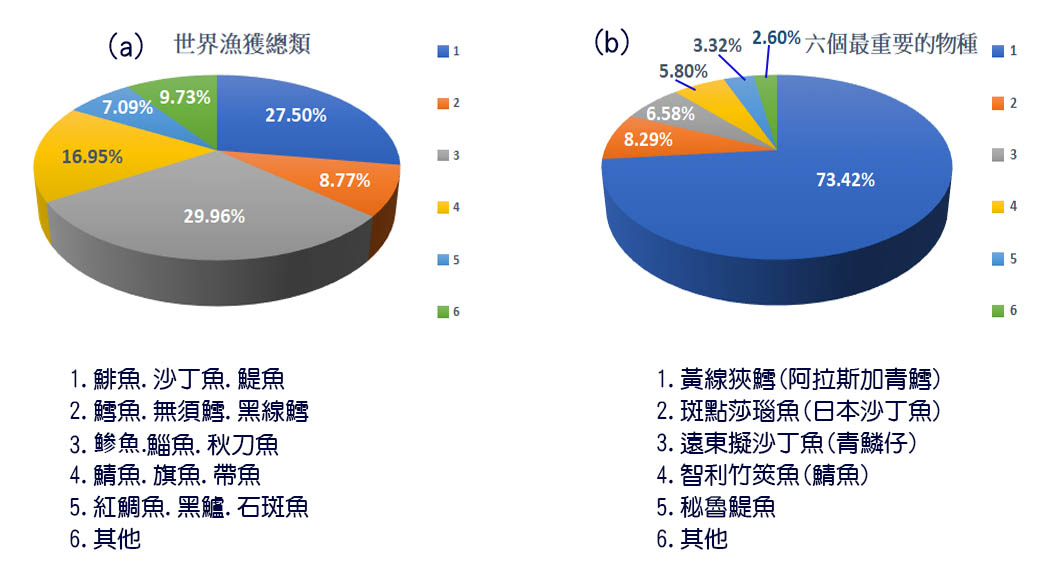
圖8.10 1987年世界漁獲物組成:(a)主要類群;(b)六個最重要的物種。總漁獲量8083.7萬噸。糧農組織漁業統計資料,1987年。
北海是一個淺而多產的溫帶海洋,與工業化國家接壤。其中一些有著悠久的商業漁業傳統。總漁獲量約為11種,但隨著時間的推移,這些物種的相對重要性發生了變化(Cole和Holden, 1973;Cushing, 1988;McIntyre, 1988)。在第二次世界大戰後的最初25年裡,由漂流刺網捕獲的鯡魚以及後來被中型拖網捕撈的鯡魚占了主要地位。在20世紀60年代中期,圈錢變得很重要。1973年之後,鯡魚漁場崩潰, 1977年漁場關閉。上世紀80年代,種群恢復,捕魚業恢復。另一種中上層魚類鯖魚的開發在20世紀60年代和70年代都是類似的大規模開發和崩潰的模式。相比之下,包括鱈魚、黑線鱈和鱈魚在內的底棲鱈魚的開發在20世紀60年代和70年代有所增加。底棲沙鰻的開發也有大幅度增加以及遠海水母。後一種物種太小,不足以吸引人類直接食用,但被用來生產魚粉和魚油。鯡魚 漁業的崩潰說明了更有效和更密集的漁業對一個物種的影響。最初,漁場會將年紀較大、體型較大的魚捕撈出來,從而依賴於幼小的魚類。魚是在性成熟之前或之後 不久被捕獲的。漁場的繁衍成功只依賴於一小部分一年的魚群,每一級都由小魚組成。然後,捕撈壓力只需小幅增加,也許再加上不利的氣候條件,繁殖和招募就會 崩潰。
目前尚不清楚的是,鮪魚種群的增加是通過捕食性和競爭性的相互作用與鯡魚和鯖魚種群的減少有因果關係,還是底層物種的增加和遠海物種的減少是巧合。
8.5.2.2 秘魯上升流漁業。
在正常的海洋學條件下,秘魯沿海的上升流支持了大量的浮游石首 魚,特別是秘魯鳳尾魚,以及它們的魚類和鳥類捕食者。每隔幾年,溫暖、缺乏營養的水就會向南氾濫,取代營養豐富的水域。鳳尾魚數量減少,通常隨著溫暖的海 水退去而恢復。週期性事件被稱為厄爾尼諾。鳳尾魚是一種短命物種,因此它的種群規模往往密切跟蹤這種環境變化。
秘魯在1950年代和1960年代中期開發了一個主要的anchoveta漁場,是世界上最重要的漁場, 1970年的漁獲量為1300萬噸(Cushing, 1982年;Csirke, 1988年)。1972年,種群和漁業崩潰,隨後沒有恢復到以前的豐度。這次崩塌可能是1971-72年強烈的厄爾尼諾現象和在此期間持續的沉重的捕魚壓力共同作用的結果。當時,漁業管理人員採用了傳統的假設,即無論種群多少,招募人數都將保持相對不變,但出現了過度捕撈的情況。這種漁業的一個特點是它強調單一物種。具有諷刺意味的是,厄爾尼諾現象在陸地上被稱為“豐收年”,因為它給乾旱的海岸線帶來了雨水(Philander, 1990年)。
8.5.2.3 泰國灣漁業。
20世紀60年代,在這片熱帶海域建立了一個底棲拖網產業(Pauly, 1988)。與北海和秘魯漁業完全不同的是,約有150種魚類對漁業做出了重大貢獻,因為其年產量從1960年的6萬噸增加到1980年的80萬噸。隨著漁業的發展,漁獲物的組成發生了重大變化。大型的,長壽的軟骨魚類動物(鰩魚和鋸魚)實際上已經消失了。它們的低繁殖力使它們容易過度捕撈。大個體的科,如蜥蜴科已經消失,但魷魚,一種無脊椎動物的捕食者,在捕獲量中的比例有所增加。
基於少數魚種的漁業管理是困難的,因為與成年種群的數量相比,漁業招募的魚類數量有所不同。一個漁業包括100多個物種,每一個物種都有自己的生活史模式,而且每一個物種都受到影響其繁殖成功的各種因素的影響,這一問題的複雜性可與最複雜的物理系統相媲美。管理多物種漁業的技術發展對漁業生物學家來說是一個艱巨的挑戰。
8.5.3 海洋水產養殖
一些價值很高的物種在海裡用類似於湖泊的網箱養殖方法進行養殖。潮汐和水流的漲落會將水和一些天然食物沖進漂浮的籠子。最初,這些籠子被安置在有遮蔽的海灣、小灣和海灣,那裡有足夠的水流運動,但可以躲避風暴。隨著技術的改進,可以在更開闊水域使用的網箱已經開發出來。密集的海洋網箱養殖的主要中心是加拿大、愛爾蘭、蘇格蘭和挪威的西海岸以及日本、台灣附近海域。
北美和歐洲的中心生產鮭魚,特別是大西洋鮭魚。網箱養殖鮭魚的發展將在一定程度上緩解這一寶貴資源的捕撈壓力。到1985年,年產量為4萬噸(Shepherd和Bromage, 1988年),總產量(漁業加養殖)為49 158噸(糧農組織, 1987年)。在日本,主要的養殖物種是黃尾魚(Seriola quinqueradiata)、紅海鯛(Pagrus major)和越來越重要的日本比目魚(Paralichthys olivaceus)。1983年,海洋物種的產量為191,000噸。
這些集約化的海洋水產養殖業都依賴於工業漁業生產用於製造顆粒食品的魚粉。因此,從某種意義上說,水產養殖業是寄生在漁業上的,而不是開發不同資源的並行 發展。自相矛盾的是,集約化水產養殖業的擴張非但不能緩解自然種群的捕撈壓力,反而可能使其增加。這就更加迫切需要繼續改進和實施漁業管理和管理技術,並 充分評估環境劣化對商業開發種群造成的危險。所有這些都將取決於我們對魚類與環境之間關係的理解的不斷發展。
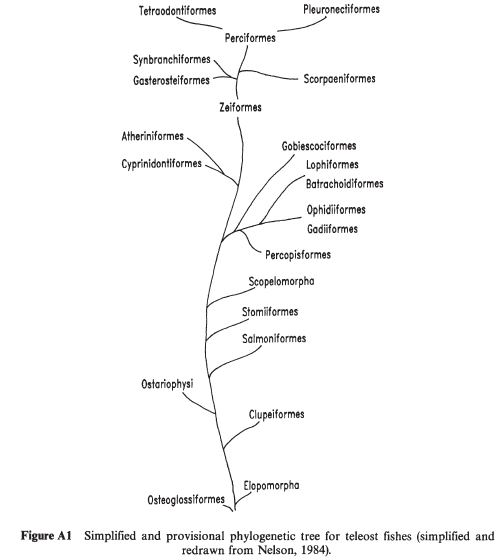
Classification of living
fishes (based on Nelson, 1984). All Orders but only
selected Families relevant
to the text are given.
Superclass: AGNATHA (jawless fishes)
Order: Myxiniformes
(hagfishes)
Order: Petromyzontiformes
(lampreys)
Superclass: GNATHOSTOMATA (jawed fishes)
Class: Chondrichthyes (cartilaginous fishes)
Subclass: Holocephali
Order: Chimaeriformes
(chimaeras)
Subclass: Elasmobranchii (sharks and rays)
Order: Hexanchiformes
e.g. cow shark
: Heterodontiformes e.g. Port Jackson shark
: Lamniformes e.g. basking
shark, mackerel shark
: Squaliformes e.g. dogfish
: Rajiformes (sharks
and rays)
Class: Osteichthyes (bony fishes)
Subclass: Dipneusti (lungfishes)
Order: Ceratodontiformes
: Lepidosireniformes
Subclass: Crossopterygii
Order: Coelacanthiformes
e.g. Latimeria
Subclass: Brachiopterygii (bichirs)
Order: Polypteriformes
e.g. Polypterus
Subclass: Actinopterygii (ray-finned fishes)
Infrac1ass: Chondrostei
Order: Acipenseriformes
(sturgeons and paddlefish)
Infrac1ass: Neopterygi
'Holosteans'
Order: Lepisosteiformes
(gars)
: Amiiformes
(bowfin)
'Teleosts'
Order: Osteoglossiformes
e.g. Osteoglossidae, Mormyridae, Gymnarchidae
Elopiformes e.g. Megalopidae (tarpons)
Notacanthiformes e.g. Halosauridae
Anguilliformes e.g. Anguillidae (eels)
Clupeiformes e.g. Clupeidae (herrings), Engraulidae
(anchovies)
'Superorder Ostariophysi'
Order: Gonorynchiformes
e.g. Chanidae (milkfish)
Cypriniformes e.g. Cyprinidae (carps etc.), Catostomidae
(suckers), Cobitididae
(loaches)
Characiformes e.g. Curimatidae
Siluriformes (catfishes) e.g. Ictaluridae, Loricariidae,
Ariidae
Gymnotiformes e.g. Gymnotidae
'Superorder: Protoacanthopterygii'
Order: Salmoniformes
e.g. Salmonidae (salmon, trout, char,
whitefish), Esocidae
(pikes), Umbridae (mud minnows)
'Superorder: Stenopterygii'
Order: Stomiiformes
e.g. Gonostomatidae, Stomiidae
'Superorder: Scopelomorpha'
Order: Aulopiformes
e.g. Synodontidae
: Myctophiformes
e.g. Myctophidae (lanternfishes)
'Superorder: Paracanthopterygii'
Order: Percopsiformes
e.g. Percopsidae (troutperches)
Gadiformes: Gadidae
(cods), Macrouridae (rattails)
Ophidiiformes
Batrachoidiformes
Lophiiformes (anglerfishes) e.g. Ceratiidae
Gobiesociformes e.g. Gobiesocidae (clingfishes)
'Superorder: Acanthopterygii'
Order: Cyprindontiformes
e.g. Exocoetidae (flyingfishes),
Cyprinodontidae
(killifishes), Poeciliidae
Atheriniformes e.g. Atherinidae (silversides)
Lampriformes
Beryciformes e.g. Holocentridae (squirrelfishes)
Zeiformes e.g. Zeidae (dories)
Gasterosteiformes e.g. Gasterosteidae (sticklebacks)
Indostomiformes
Pegasiformes e.g. Pegasidae (sea moths)
Syngnathiformes e.g. Syngnathidae (pipefish and seahorses)
Dactylopteriformes
Synbranchiformes e.g. Synbranchidae (swamp eels)
Scorpaeniformes e.g. Scorpaenidae (rockfishes), Cottidae
(sculpins)
Perciformes e.g. Percidae, Cichlidae,
Centrarchidae,
Chaetodontidae, Pomacentridae,
Scombridae, Carangidae
Pleuronectiformes (flatfishes) e.g. Pleuronectidae (plaice)
Tetraodontiformes e.g. Balisitidae (triggerfish), Molidae
(sunfish)
REFERENCES
Achieng, A.P. (1990). The
impact of the introduction of Nile perch, Lates niloticus
(L.) on
the fisheries of Lake
Victoria. J. Fish Bioi., 37 (Suppl. A), 17-23.
Adams, D.D. and Page,
W.P. (1985). Acid Deposition. Environmental. Economic and Policy
Issues. Plenum. New York.
Alabaster, J.S. and
Lloyd, R. (1982). Water Quality Criteria for Freshwater Fish, 2nd edn.
Butterworth Scientific,
Guildford.
Aim, G. (1959).
Connection between maturity, size and age in fishes. Rep. Inst. Freshwat.
Res. (Drottningholm),
40, 5-145.
Angermeier, P.L. and Karr, J.R.
(1984). 'Fish communities along environmental gradients
in a system of tropical
streams' in Evolutionary Ecology of Neotropical Freshwater Fishes,
T. M. Zaret
(ed.), Dr W. Junk (publisher), The Hague, pp. 39-57.
Arnold, G.P. (1981).
'Movements of fish in relation to water currents' in Animal Migration,
D.J. Aidley
(ed.), Cambridge University Press, Cambridge, pp. 54-79.
Aronson, L.R. (1951).
Orientation and jumping behaviour in the gobiid fish Bathygobius
saporator. Am. Mus. Novit., 1486, 1-21.
Bagenal, T.B. (1978). 'Aspects
of fish fecundity' in Ecology of Fish Production, S.D. Gerking
(ed.), Blackwell, Oxford,
pp. 75-101.
Bailey, K.M. and Houde, E.D. (1989). Predation on eggs and larvae of marine
fishes and
the recruitment problem. Adv.
Mar. Bioi., 25, 1-83.
Balon, E.K. (1975).
Reproductive guilds of fishes: a proposal and definition. J. Fish. Res.
Bd. Can., 32,821-864.
Balon, E.K., Bruton, M.N. and
Fricke, H. (1988). A fiftieth anniversary reflection on the
living coelacanth, Latimeria
chalumnae: some new interpretations of its natural history
and conservation status. Env.
Bioi. Fish., 23, 241-280.
Bardach, lE.,
Ryther, J.H. and McLarney, W.O. (1972). Aquaculture.
Wiley-Interscience,
New York.
Bayliff, W.H. (1980). Synopses
of biological data on eight species of scombrids. Inter-Am.
Trop. Tuna Comm. Sp.
Rep., 2, 1-530.
Beamish, F.W.H. (1978).
'Swimming capacity' in Fish Physiology, Vol. VIII, W.S. Hoar and
DJ. Randall (eds.)
Academic Press, London, pp. 101-187.
Beamish, F.W.H. and Medland, T.E. (1988). Age determination in lampreys. Trans.
Am.
Fish. Soc., 117, 63-71.
Begon, M., Harper, J.L. and
Townsend, c.R. (1989). Ecology. Individuals.
Populations and
Communities (2nd edn). Blackwell, Oxford.
Beveridge, M. (1987). Cage
Aquaculture. Fishing News Books Ltd, Farnham.
Beverton, R.1.H. and Holt, S.J.
(1957). On the dynamics of exploited fish populations. Fishery
Invest. (London), 19, 533.
Bishop, lE. (1973). Limnology of a Small Malayan River Sungai
Gombak. Dr W. Junk
(publisher), The Hague.
Blaxter, J.H.S. and Hunter, J.R.
(1982). The biology of the clupeoid fishes. Adv. Mar. BioI.,
20, 1-223.
Bleckmann, H. (1986). 'Role of the
lateral line in fish behaviour' in The Behaviour of Teleost
Fishes, TJ. Pitcher, (ed.), Croom
Helm, London, pp. 177-202.
Bond, C.E. (1979). Biology
of Fishes. W.B. Saunders, Philadelphia.
Bone, Q. and Marshall,
N.B. (1982). Biology of Fishes. Blackie, Glasgow.
Bowen, S.H. (1984). 'Detritivory in neotropical fish communities' in Evolutionary
Ecology
of Neotropical Freshwater
Fishes, T.M. Zaret
(ed.), Dr W. Junk (publisher), The Hague,
pp.59-66.
Brafield, A.E. and Llewellyn, MJ.
(1982). Animal Energetics. Blackie, Glasgow.
Brander, K. (1988).
'Multispecies fisheries of the Irish Sea' in Fish Population Dynamics (2nd
edn.), J.A. Gulland (ed.), John
Wiley, Chichester, pp. 303-328.
Brandt, S.B., Magnuson,
J.J. and Crowder, L.B. (1980) Thermal habitat partitioning by fishes
in Lake Michigan. Can.
J. Fish. Aquat. Sci., 37, 1557-1564.
Breder, C.M. Jun. and Rosen,
D.E. (1966). Modes of Reproduction in Fishes. Natural History
Press, New York.
Brett, J.R. (1971).
Energetics responses of salmon to temperature. A study of some thermal
relations in the
physiology and freshwater ecology of the sockeye salmon (Oncorhynchus
nerka). Am. Zool., 11, 99-113.
Brett, J.R. (1979).
'Environmental factors and growth', in Fish Physiology, Vol. VIII, W.S.
Hoar, DJ. Randall and
J.R. Brett (eds.), Academic Press, London, pp. 599-675.
Brett, J.R. (1983). 'Life
energetics of sockeye salmon, Oncorhynchus nerka' in Behavioural
Energetics: the Cost of Survival in Vertebrates, W.P. Aspey
and S.I. Lustick (eds.), Ohio
State University Press,
Columbus, pp. 29-63.
Brett, J.R. and Groves,
T.D.D. (1979). 'Physiological energetics' in Fish Physiology, Vol. VIII,
W.S. Hoar, DJ. Randall
and J.R. Brett (eds.), Academic Press, London, pp. 279-352.
Budker, P. (1971). The Life
of Sharks. Weidenfeld and Nicolson, London.
Castleberry, D.T. and
Cech, J.I. Jr. (1986). Physiological responses of a native and an
introduced desert fish to
environmental stressors. Ecology, 67, 912-918.
Caughley, G. (1977). Analysis
of Vertebrate Populations. I. Wiley, Chichester.
Childress, J.J., Taylor,
S.M., Cailliet, G.M. and Price, M.H. (1980). Patterns
of growth, energy
utilization and
reproduction in some meso- and bathypelagic fishes off Southern California.
Mar. BioI.,
61, 27-40.
Christie, WJ. (1974).
Changes in the fish species composition of the Great Lakes. J. Fish.
Res. Bd. Can., 31, 827-854.
Christie, WJ., Spangler,
G.R., Loftus, K.H., Hartman, W.L., Colby, PJ., Ross, M.A. and
Talhelm, D.R. (1987). A
perspective on Great Lakes fish community rehabilitation. Can.
J. Fish. Aquat. Sci., 44 (Suppl. 2), 486-499.
Clark, C.W. and Levy,
D.A. (1988). Diel vertical migrations by juvenile sockeye salmon and
the antipredator window. Amer.
Nat., 131,271-290.
Clark, R.B. (1989). Marine
Pollution (2nd end.). Clarendon Press, Oxford.
Cohen, Y. and Stone, J.N.
(1987). Multivariate time series analysis of the Canadian fisheries
system in Lake Superior. Can.
J. Fish. Aquat. Sci., 44 (Suppl. 2),171-181.
Cole, H.A. and Holden,
M.J. (1973). 'History of the North Sea fisheries' in North Sea Science,
E.D. Goldberg, (ed.),
M.I.T. Press, Cambridge, Mass., pp. 337-360.
Colt, J. (1984).
Computation of dissolved gas concentrations in water as functions of
temperature, salinity and
pressure. Am. Fish. Soc. Spec. Pub!., 14, 154.
Conover, D.O. and Heins, S.W. (1987). Adaptive variation in environmental and
genetic sex
determination in a fish. Nature,
326, 496-498.
Craig, J. (1987). The
Perch. Croom Helm, London.
Csirke, J. (1988). 'Small
shoaling pelagic fish stocks' in Fish Population Dynamics (2nd edn.),
J.A. Gulland, (ed.),
Wiley-Interscience, New York, pp. 271-302.
Cushing, D.H. (1975). Marine
Ecology and Fisheries. Cambridge University Press, Cambridge.
Cushing, D.H. (1982). Climate
and Fisheries. Academic Press, London.
Cushing, D.H. (1988). The Provident Sea. Cambridge
University Press, Cambridge.
Cushing, D.H. (1990).
Plankton production and year-class strength in fish populations: an
update of the
match/mismatch hypothesis. Adv. Mar. Bioi., 26,
249-293.
Dando, P.R. (1984).
'Reproduction in estuarine fish' in Fish Reproduction: Strategies and
Tactics, G.W. Potts and R.I.
Wootton (eds.), Academic Press, London, pp. 155-170.
Day, J.H., Blaber, S.I.M. and Wallace, J.H. (1981). 'Estuarine fishes'
in Estuarine Ecology,
J.H. Day (ed.), A.A. Balkema, Rotterdam, pp. 197-221.
DeVlaming, (1971). The effects of
food deprivation and salinity changes on reproductive
function in the estuarine
gobiid fish, Gillichthys mirabilis. Bioi. Bull., 141, 458-471.
DeVries, A.L. (1971).
'Freezing resistance in fishes' in Fish Physiology, Vo!' VI, W.S. Hoar
and D.J. Randall (eds.),
Academic Press, London, pp. 157-190.
Douglas, R.H. and Djamgoz, M.B.A. (1990). The Visual System of Fish. Chapman
and Hall,
London.
Echelle, A.A. and Kornfield,
I. (eds.) (1984). Evolution of Fish Species Flocks. University of
Maine Press, Orono,
Maine.
Edwards, R.W., Gee, A.S.
and Stoner, J.H. (1990). Acid Waters in Wales. Kluwer Academic
Publishers, London.
Eggers, D.M. (1977). The
nature of prey selection by planktivorous fish. Ecology, 63, 381-390.
Elgar, M.A. (1990).
Evolutionary compromise between a few large and many small eggs:
comparative evidence in
teleost fish. Oikos, 59, 283-287.
Elliott, J.M. (1975).
Number of meals in a day, maximum weight of food consumed in a day
and maximum rate of
feeding for brown trout, Salmo trutta L. Freshwat.
Bioi., 5, 287-303.
Elliott, J.M. (1979).
Energetics of freshwater teleosts. Symp. Zool. Soc. Lond.,
44, 29-61.
Elliott, J.M. (1981).
'Some aspects of thermal stress on freshwater teleosts'
in Stress and Fish,
A.D. Pickering (ed.),
Academic Press, London, pp. 209-245.
Elliott, J.M. (1985).
Population regulation for different life-stages of migratory trout, Salmo
trutta in a Lake District
stream, 1966-83. J. Anim. Eco!', 54, 617-638.
Elliott, J.M. (1989).
Mechanisms responsible for population regulation in young migratory
trout, Salmo trutta. I.
The critical time for survival. J. Anim. Ecol., 58, 987-1001.
Everson, I. (1984). 'Fish
biology' in Antarctic Ecology, R.M. Laws (ed.), Academic Press,
London, pp. 157-190.
F.A.O. (1981). Atlas
of the Living Resources of the Seas. F.A.O., Rome.
Fausch, K.D. (1984). Profitable
stream positions for salmon ids relating specific growth rate
to net energy gain. Can.
J. Zool., 62, 441-451.
Fischer, E.A. (1986).
'Mating systems of simultaneously hermaphroditic serranid fishes' in
Indo-Pacific Fish
Biology, T. Uyeno,
R. Arai, T. Taniuchi and K. Matsuura (eds.),
Ichthyological Society of
Japan, Tokyo, pp. 776-784.
Fish, J.D. and Fish, S.
(1989). A Student's Guide to the Seashore. Unwin Hyman, London.
FitzGerald, G.I. and Whoriskey, F.G. (1985). The effects of interspecific
interactions upon
male reproductive success
in two sympatric sticklebacks, Gasterosteus
aculeatus and G.
wheatlandi. Behaviour,
93, 112-125.
Foester, R.E. (1968). The
sockeye salmon, Oncorhynchus nerka. Bull. Fish Res. Bd. Can., 162,
1-442.
Fricke, R., Handermann, H., Stahlberg, S. and Peck mann,
P. (1987). The compatible critical
swimming speed: a new
measure for the specific swimming performance of fishes. Zool.
Jb. Physiol., 91, 101-111.
Fry, F.E.J. (1971). 'The
effect of environmental factors on the physiology of fish' in Fish
Physiology Vol. VI, W.S. Hoar and D.I. Randall
(eds.), Academic Press, London, pp. 1-98.
Fryer, G. and IIes, T.D. (1972). The Cichlid Fishes of the Great
Lakes, Oliver and Boyd,
Edinburgh.
Furness, R.W. (1982).
Competition between fisheries and seabird communities. Adv. Mar.
Bioi., 20, 225-307.
Gee, J.H., Tallman, R.F.
and Smart, H. (1978). Reaction of some great plains
fishes to
progressive hypoxia. Can.
J. Zool.,56, 1962-1966.
Gee, lM.
(1989). An ecological and economic review of meiofauna as food for fish. Zool.
J.
Linn. Soc., 96, 243-261.
Gerking, S.D. (1989). The
restricted movements of fish populations. Bioi
Rev., 34,221-
242.
Gibson, R.N. (1969). The
biology and behaviour of littoral fish. Oceanogr. Mar. Bioi.
Ann.
Rev., 7, 367-410.
Gibson, R.N. (1982).
Recent studies on the biology of intertidal fishes. Oceanogr.
Mar. Bioi.
Ann. Rev., 20, 363-414.
Gibson, R.N. (1986).
'Intertidal teleosts: life in a fluctuating
environment' in The Behaviour
of Teleost Fishes, T.I. Pitcher (ed.), Croom
Helm, London, pp. 388-408.
Giller, P.S. (1984). Community
Structure and the Niche. Chapman and Hall, London.
Giller, P.S. and Gee, J.H.R.
(1987). 'The analysis of community organization: the influence
of equilibrium, scale and
terminology' in Organization of Communities Past and Present,
J.H.R. Gee and P.S. Giller (eds.), Blackwell, Oxford, pp. 519-542.
Glebe, B.D. and Leggett, W.e. (1981). Latitudinal differences in energy allocation
and use
during the freshwater
migrations of the American shad (Alosa sapidissima)
and their
life-history
consequences. Can. J. Fish. Aquat. Sci., 38,
806-820.
Goldman, B. and Talbot,
F.H. (1976). 'Aspects of the ecology of coral reef fishes' in Biology
and Geology of Coral
Reefs III, O.A.
Jones and R. Endean (eds.), Academic Press, London,
pp.125-154.
Gordon, J.D.M. (1979).
Lifestyle and phenology in deep-sea Anacanthine teleosts. Symp.
Zoo!. Soc. Lond.,
44, 327-359.
Gorman, O.T. (1987).
'Habitat segregation in an assemblage of minnows in an Ozark stream'
in Community and
Evolutionary Ecology of North American Stream Fishes, W.I. Matthews
and D.e.
Heins (eds.), University of Oklahoma Press, Normal,
pp. 33-41.
Goulding, M. (1980). The
Fishes and the Forest: Explorations in Amazonian Natural History.
University of California
Press, Berkeley.
Goulding, M., Carvalho,
M.L. and Ferreira, E.G. (1988). Rio Negro, Rich Life in Poor Water.
SPB Academic Publishing,
The Hague.
Graham, J.B. (1983).
'Heat transfer' in Fish Biomechanics, P.W. Webb and D. Weihs (eds.),
Praeger, New York, pp.
248-279.
Green, J.M. (1971).
High-tide movements and homing behaviour of the tidepool
sculpin
Oligocottus maculosus.
J. Fish. Res. Bd.
Can., 28, 383-389.
Gross, M.R. (1984).
'Sunfish, salmon and the evolution of alternative reproductive strategies
and tactics in fishes' in
Fish Reproduction: Strategies and Tactics, G.W. Potts and R.I.
Wootton (eds.), Academic
Press, London, pp. 55-75.
Gross, M.R. (1987).
Evolution of diadromy in fishes. Amer. Fish. Soc. Symp., 1, 14-25.
Grossman, G.D. (1982).
Dynamics and oganization of a rocky inter-tidal
assemblage: the
persistence and
resilience of taxocene structure. Amer. Nat., 119,
611-637.
Grossman, G.D. (1986).
Food partitioning in a rocky intertidal fish assemblage. J. Zool.
Lond. (B), 1, 317-355.
Grossman, G.D., Moyle,
P.B. and Whitaker, J.O. Jr. (1982). Stochasticity in structural and
functional
characteristics of an Indiana stream fish assemblage: a test of community
theory.
Amer. Nat., 120,423-454.
Guthrie, D.M. (1986).
'Role of vision in fish behaviour' in The Behaviour of Teleost Fishes,
T.J. Pitcher (ed.), Croom
Helm, London, pp. 75-113.
Halver, J.E. (1989) Fish
Nutrition, (2nd edn.) Academic Press, London.
Hanlon, R.D.G. (1981).
Allochthonous plant litter as a source of organic material in an
oligtrophic lake (Llyn Frongoch). Hydrobiologia, 80, 257-261.
Harden Jones, F.R.
(1968). Fish Migration. Edward Arnold, London.
Harden Jones, F.R.
(1981). 'Fish migration: strategy and tactics' in Animal Migration, D.J.
Aidley (ed.), Cambridge
University Press, Cambridge, pp. 139-165.
Hardisty, M.W. (1979). The
Biology of the Cyclostomes. Chapman and Hall, London.
Hardisty, M.W. (1986).
'General introduction to lampreys' in The Freshwater Fishes of Europe, Vol
1, Part 1. PetromyzontiJormes, J. HoIcik, (ed.), AULA-Verlag, Wiesbaden,
pp.17-83.
Hardisty, M.W. and
Potter, I.e. (1971). 'The behaviour, ecology and
growth of larval
lampreys' in The
Biology of Lampreys, M.W. Hardisty and I.e. Potter
(eds.), Academic
Press, London, pp.
85-125.
Hart, PJ.B. (1986).
'Foraging in teleost fishes' in The Behaviour of Te/eost Fishes, T.J. Pitcher
(ed.), Croom Helm,
London, pp. 211-235.
Hasler, A.D. and Scholz,
A.T. (1983). Olfactory Imprinting and Homing in Salmon.
Springer-Verlag, Berlin.
Hawkins, A.D. (1986).
'Underwater sound and fish behaviour' in The Behaviour of Teleost
Fishes, T.J. Pitcher (ed.), Croom
Helm, London, pp. 114-151.
Hearn, W.E. (1987).
Interspecific competition and habitat segregation among stream-dwelling
trout: a review. Fisheries,
12, 24-31.
Helfman, G.S. (1981). Twilight
activities and temporal structure in a freshwater fish
community. Can. J.
Fish. Aquat. Sci., 38, 1405-1420.
Helfman, G.S. (1986). 'Fish behaviour by day, night and twilight' in The Behaviour of Teleost
Fishes, T.J. Pitcher (ed.), Croom
Helm, London, pp.366-387.
Henderson, P.A. (1985).
An approach to the prediction of temperate freshwater fish
communities. J. Fish. Bioi., 27 (SuppJ. A),
279-291.
Henderson, P.A. and
Walker, I. (1990). Spatial organization and popUlation
density of the
fish community of the
litter banks within a central Amazonian blackwater stream. J. Fish
Bioi., 37, 401-411.
Hildrew, A.G. (1990). Fish
predation and the organization of invertebrate communities in
streams. Pol. Arch. Hydrobiol., 37, 95-107.
Hixon, M.A. (1980).
Competitive interactions between California reef fishes of the genus
Embiotoca. Ecology, 61, 918-931.
Hoar, W.S. and Randall,
D.J. (1978). 'Terminology to describe swimming activity in fish' in
Fish Physiology, Vol. VIJ,
W.S. Hoar and DJ. Randall
(eds.), Academic Press, London,
xiii-xiv.
Hochachka, P.W. (1980). Living
Without Oxygen. Harvard University Press, Harvard.
Hockachka, P.W. and Somero, G.N. (1984). Biochemical Adaptation. Princeton
University
Press, Princeton.
Hoekstra, D. and Janssen,
J. (1985). Non-visual feeding behaviour of the
mottled sculpin,
Cottus bairdi,
in Lake Michigan. Env.
Bioi. Fish., 12, 111-117.
Hokanson, K.E.F. (1977).
Temperature requirements of some percids and adaptations to
the seasonal temperature cycle. J. Fish. Res. Bd. Can., 34, 1524-1550.
Horn, M.H. (1972). The
amount of space available for marine and freshwater fishes. Fish.
Bull., 70, 1295-1297.
Horn, M.H. (1989).
Biology of marine herbivorous fishes. Oceanogr.
Mar. Bioi. Ann. Rev.,
27, 167-272.
Horne, J.K. and Campana,
S.E. (1989). Environmental factors influencing the distribution
of juvenile groundfish in
near-shore habitats off southwest Nova Scotia. Can. J. Fish.
Aquat. Sci., 46, 1277-1286.
Huet, M. (1959). Profiles and
biology of western European streams as related to fish
management. Trans. Am.
Fish. Soc., 88,153-163.
Hughes, G.M. (1984).
'General anatomy of gills' in Fish Physiology, Vol. X A, W.S. Hoar
and D.J. Randall (eds.),
Academic Press, London, pp. 1-72.
Ibrahim, A.A. and Huntingford, F.A. (1989). The role of visual cues in prey
selection in
three-spined sticklebacks
(Gasterosteus aculeatus). Ethology, 81,
265-272.
Jenkins, T.M. Jf. (1969). Social structure, position choice and microdistribution of two trout
species (Salmo trutta and
Salmo gairdneri) resident in mountain streams.
Anim. Behav.
Monogr., 2, 56-123.
Johansen, K. (1970). 'Air
breathing in fishes' in Fish Physiology, Vol. lV, W.S.
Hoar and D.J.
Randall (eds.), Academic Press, London, pp.
361-411.
Johannes, P.E. (1981). Words
of the Lagoon, University of California Press, Berkeley.
Johnston, R. (1976).
'Mechanisms and problems of marine pollution in relation to commercial
fisheries' in Marine
Pollution, R. Johnston (ed.), Academic Press, London, pp. 3-156.
Jordan, D.R. and Wortley,
J.S. (1985). Sampling strategy related to fish distribution, with
particular reference to
the Norfolk Broads. J. Fish Bioi., 27 (SuppJ. A), 163-173.
Keast, A. (1978). Trophic and
spatial interrelationships in the fish species of an Ontario
temperate lake. Env. Bioi. Fish., 13,211-224.
Keast, A. and Webb, D. (1966).
Mouth and body form relative to feeding ecology in the fish
fauna of a small lake,
Lake Opinicon, Ontario. J. Fish. Res. Bd. Can., 23,1845-1874.
Kramer, D.L. (1983). The
evolutionary ecology of respiratory mode in fishes: an analysis
based on the cost of
breathing. Env. Bioi. Fish., 9, 145-158.
Krebs, CJ. (1985). Ecology:
The Experimental Analysis of Distribution and Abundance (3rd
edn) Harper and Row, New York.
Lambert, T.C and Ware,
D.M. (1984). Reproductive strategies of demersal and pelagic
spawning fish. Can. J.
Fish. Aquat. Sci., 41,1565-1569.
Leggett, W.C (1984).
'Fish migration in coastal and estuarine environments: a call for new
approaches to the study
of an old problem' in Mechanisms of Migration in Fishes, J.D.
McCleave, G.P. Arnold, J.l Dodson and W.H. Neill (eds.), Plenum, New York,
pp. 159-178.
Leggett, W.C, Frank, K.T.
and Carscadden, J.E. (1984). Metereological
and hydrographic
regulation of year·class strength in capelin (Mallotus
villosus). Can. J. Fish. Aquat.
Sci.,
41, 1193-1201.
Li, H.W., Schreck, CB.,
Bond, CE. and Rexstad, E. (1987). 'Factors
influencing changes in
fish assemblages of
Pacific Northwest streams' in Community and Evolutionary Ecology
of North American Stream
Fishes, W.J. Matthews and D.C Heins (eds.), University of
Oklahoma Press, Normal,
pp. 193-202.
Lindsey, CC (1966). Body
size of poikilotherms at different latitudes. Evolution, 20, 456-465.
Linfield, R.S.l (1985). An alternative concept to home·range
theory with respect to population
of cyprinids in major
river systems. J. Fish. Bioi., 27 (SuppJ. A), 187-196.
Longhurst, A.R. and
Pauly, D. (1987). Ecology of Tropical Oceans. Academic Press, London.
Lotrich, V.A. (1973). Growth,
production and community composition of fishes inhabiting
a first·, second· and third·order stream of eastern Kentucky. Ecol. Monogr., 43, 377-397.
Lowe-McConnell, R.H.
(1987). Ecological Studies in Tropical Fish Communities. Cambridge
University Press,
Cambridge.
Lundberg, J.G., Lewis,
W.M. Jr, Saunders, J.F. III and Mago·Leccia, F.
(1987). A major
food web component in the
Orinoco River channel: evidence from planktivorous fishes.
Science, 237, 81-83.
Lythgoe, J.N. (1979). The
Ecology of Vision. Oxford University Press, Oxford.
McClusky, D.S. (1989). The
Estuarine Ecosystem (2nd edn.), Blackie, Glasgow.
MacDonald, J.A.,
Montgomery, J.C and Wells, R.M.G. (1987). Comparative physiology of
Antarctic fishes. Adv.
Mar. Bioi., 24,321-388.
McDowall, R.M. (1988). Diadromy in Fishes. Croom Helm, London.
McGurk, M.D. (1986).
Natural mortality of marine pelagic eggs and larvae: role of spatial
patchiness. Mar. Ecoi. Progr. Series, 34,
227-242.
McIntyre, A.D. (1988).
'Fishery resources' in Pollution of the North Sea, W. Salomons, B.L.
Bayne, E.K. Duursma and U. Forstner (eds.),
Springer· Verlag, Berlin, pp. 152-163.
McKaye, K.R. (1977).
Competition for breeding sites between the cichlid fishes of Lake Jiloa,
Nicaragua. Ecology, 58,
291-302.
McKaye, K.R. and Gray, W.N.
(1984). 'Extrinsic barriers to gene flow in rock·dwelling
cichlids of Lake Malawi:
macro habitat heterogeneity and reef colonization' in Evolution
of Fish Species Flocks, A.A. Echelle and I.
Kornfield (eds.), University of Maine Press,
Orano, pp. 245-273.
Mann, R.H.K. and Penczak, T. (1986). Fish production in rivers: a review. Polskie. Arch.
Hydrobiol., 33, 233-247.
Marshall, N.B. (1979). Developments in Deep·Sea Biology. Blandford Press, Poole.
Marshall, N.B. (1984). 'Progenetic tendencies in deep-sea fishes' in Fish
Reproduction:
Strategies and Tactics, G.W. Potts and R.I.
Wootton (eds.), Academic Press, London,
pp.92-101.
Marshall, T.R. and Ryan,
P.A. (1987). Abundance patterns and community attributes of
fishes relative to
environmental gradients. Can. J. Fish. Aquat.
Sci., 44 (SuppJ. 2),198-215.
Martin, T.I. (1988).
Interaction of salinity and temperature as a mechanism for spatial
separation of three
co-existing species of Ambassidae (Cuvier)
(Teleostei) in estuaries on
the south-east coast of
Africa. J. Fish BioI., 33 (Suppl. A),
9-15.
Matthews, W.I. (1987).
'Physicochemical tolerance and selectivity of stream fishes as related
to their geographic
ranges and local distributions' in Community and Evolutionary Ecology
of North American Stream
Fishes, W.I. Matthews and D.C. Heins (eds.), University of
Oklahoma Press, Normal,
pp. 111-120.
Mayr, E. (1963). Animal
Species and Their Evolution. Harvard University Press, Harvard.
Meffe, G.K. and Sheldon, A.L.
(1990). Post-defaunation recovery of fish assemblages in
south-eastern blackwater
streams. Ecology, 71, 657-667.
Meybeck, M., Chapman, D.V. and
Helmer, R. (1989). Global Freshwater Quality. Blackwell,
Oxford.
Miller, P.I. (1979).
Adaptiveness and implications of small size in teleosts.
Symp. Zool. Soc.
Lond., 44, 263-306.
Mills, C.A. and Mann,
R.H.K. (1985). Environmentally-induced fluctuations in
year-class
strength and their
implications for management. J. Fish. Bioi., 27
(Suppl. A), 209-226.
Mills, D. (1971). Salmon
and Trout. Oliver and Boyd, Edinburgh.
Mills, K.H., Chalanchuk, S.M., Mohr, L.c. and Davies, 1.1. (1987).
Responses of fish
populations in Lake 223
to 8 years of experimental acidification. Can. J. Fish. Aquat.
Sci.,
44 (Suppl. 1), 114-125.
Mittelbach, G.G. (1983). Optimal
foraging and growth in bluegills. Oecologia,
59, 157-162.
Motta, P.J. (1988).
Functional morphology of the feeding apparatus of ten species of Pacific
butterflyfishes
(Perciformes: Chaetodontidae): an ecomorphological approach. Env. Bioi.
Fish., 22, 39-67.
Moyle, P.B. and Cech,
1.1. Jun. (1988). Fishes, An Introduction to Ichthyology (2nd edn.),
Prentice Hall, Englewood
Cliffs, New York.
Moyle, P.B. and Herbold,
B. (1987). 'Life-history patterns and community structure in stream
fishes of western North
America: comparisons with eastern North America and Europe'
in Community and
Evolutionary Ecology of North American Stream Fishes, W.I. Matthews
and D.C. Heins (eds.), University of Oklahoma Press, Normal, pp.
25-32.
Moyle, P.B. and Vondracek, B. (1985). Persistence and structure of the fish
assemblage in
a small California stream. Ecology, 66,1-13.
Mummert, 1.R. and Drenner, R.W. (1986). Effect of fish size on the filtering
efficiency and
selective particle
ingestion of a filter-feeding clupeid. Trans. Am. Fish. Soc., 115,
522-528.
Myrberg, A.A. Jun. and Thresher,
R.E. (1974). Interspecific aggression and its relevance to
the concept of
territoriality in fishes. Amer. Zool., 14, 81-96.
Naiman, R.I. and Soltz, D.L. (eds.) (1981). Fishes of North American
Deserts. J. Wiley, New
York.
Neilson, J.D. and Perry,
R.I. (1990). Diel vertical migrations of marine fishes: an obligate
or facultative process? Adv.
Mar. Bioi., 26, 115-168.
Neilsen, L.A., Sheehan, R.J. and
Orth, DJ. (1986). Impacts of navigation on riverine fish
production in the United
States. Pol. Arch. Hydrobiol., 33, 277-294.
Nelson, J.S. (1984). Fishes
of the World (2nd Edn.) J. Wiley, New York.
Nikolskii, G.V. (1969). Fish
Population Dynamics. Oliver & Boyd, Edinburgh.
Norman, J.R. (1963). A
History of Fishes (2nd edn.), by P.H. Greenwood.
Ernest Benn,
London.
Northcote, T.H. (1978).
'Migratory strategies and production in freshwater fishes' in Ecology
of Freshwater Fish
Production, S.D.
Gerking (ed.), Blackwell, Oxford, pp. 326-359.
O'Brien, W.J., Slade,
N.A. and Vinyard, G.L. (1976). Apparent size as the
determinant of
prey selection by bluegill sunfish (Lepomis
macrochirus). Ecology, 57, 1304-1310.
O'Hara, K. (1986). 'Fish behaviour and the management of freshwater fisheries' in The
Behaviour of Teleost Fishes, T.J. Pitcher (ed.), Croom
Helm, London, pp.496-521.
Odum, W.E. (1970). 'Utilization
of the direct grazing and plant detritus food chains by the
striped mullet, Mugi/ cephalus' in Marine
Food Chains, J.H. Steele (ed.), Oliver and Boyd,
Edinburgh, pp. 222-240.
Overholtz, W.1. and Tyler, A.V.
(1986). An exploratory simulation model of competition
and predation in a
demersal fish assemblage on Georges Bank. Trans. Amer. Fish. Soc.,
115,805-817.
Pandian, T.1. and Vivekanandan, E. (1985). 'Energetics of feeding and
digestion' in Fish
Energetics New
Perspectives, P.
Tytler and P. Calow (eds.),
Croom Helm, London,
pp.99-124.
Pauly D. (1980). On the
interrelationships between natural mortality, growth parameters
and mean environmental
temperature in 175 fish stocks. J. Cons. Perm. Int. Explor.
Mer.,
39, 175-192.
Pauly, D. (1981). The relationship
between gill surface area and growth performance in fish:
a generalization of von BertalanfTy's theory of growth. Meeresforschung,
28, 251-282.
Pauly, D. (1988).
'Fisheries research and the demersal fisheries of Southeast Asia' in Fish
Population Dynamics (2nd edn.), J.A. Gulland, (ed.), Wiley-Interscience,
New York,
pp. 329-348.
Pauly, D.R. and Morgan,
G.R. (1987). Length-based Methods in Fisheries Research. ICLARM,
Manila.
Payne, A.I. (1987). A
lake perched on piscine peril. New Scient., 115,50-54.
Penczak, T. (1985). Phosphorus,
nitrogen and carbon cycling by fish populations in two
small lowland rivers in
Poland. Hydrobiologia, 120, 159-165.
Penczak, T., Galicka,
W., Molinski, M., Kusto, E. and Zalewski,
M. (1982). The enrichment
of a meso trophic lake by
carbon, phosphorus and nitrogen from cage aquaculture of
rainbow trout, Salmo gairdneri. J. Appl. Ecol., 19, 371-393.
Persson, L., Andersson,
G., Hamrin, S.F. and Johansson, L. (1988). 'Predator
regulation and
primary production along
the productivity gradient of temperate lake ecosystems' in
Complex Interactions in
Lake Communities, S.R. Carpenter (ed.), Springer-Verlag, Berlin,
pp.45-65.
Philander, S.G.H. (1990).
El. Nino, La Nina, and the Southern Oscillation, Academic Press,
London.
Pitcher, T.J. (1986).
'Functions of shoaling behaviour in teJeosts' in The Behaviour of
Teleost
Fishes, T.1. Pitcher (ed.), Croom
Helm, London, pp. 294-338.
Pitcher, T.J. and Hart,
P.J.B. (1982). Fisheries Ecology. Croom Helm, London.
Power, M. (1987).
'Predator avoidance by grazing fishes in temperate and tropical streams:
importance of stream
depth and prey size' in Predation. Direct and Indirect Effects on
Aquatic Communities, W.C. Kerfoot and A. Sih (eds.), University Press of New England,
Hanover, pp. 333-351.
Power, M.E. (1990). EfTects offish in river food webs. Science, 250,
811-814.
Puckett, K.1. and Dill,
L.M. (1984). Cost of sustained and burst swimming to juvenile coho
salmon (Oncorhynchus
kisutch). Can. J. Fish. Aquat. Sci., 41, 1546-1551.
Quinn, T.P. {I 984). 'An
experimental approach to fish compass and map orientation' in
Mechanisms of Migration
in Fishes, J.D.
McCleave, G.P. Arnold, 1.1. Dodson and W.H.
Neill (eds.), Plenum, New
York, pp. 113-123.
Rahel, F.J. (1984). Factors
structuring fish assemblages along a bog lake
successional gradient.
Ecology, 65, 1276-1289.
Reay, P.I. (1979).
Aquaculture. Edward Arnold, London.
Reznick, D.A., Bryga, H. and Endler, J.A.
(1990). Experimentally induced life-history
evolution in a natural
population. Nature, 346, 357-359.
Ricker, W.E. (1954).
Stock and recruitment. J. Fish. Res. Board Can., 11, 559-623.
Ricker, W.E. (1979).
'Growth rates and models' in Fish Physiology Vol. VIII, W.S. Hoar,
0.1. Randall and 1.R. Brett
(eds.), Academic Press, London, pp. 677-743.
Roberts, R.I. (1989). Fish
Pathology (2nd edn.), Bailliere Tindall, London.
Robertson, D.R. (1990).
Differences in the seasonalities of spawning and
recruitment of some
small neotropical reef
fishes. J. Exp. Mar. Bioi. Ecol., 144,49-62.
Roff, D.A. (1981).
Reproductive uncertainty and the evolution of iteroparity: why don't
flatfish put all their
eggs in one basket? Can. J. Fish. Aquat. Sci., 38, 968-977.
Roff, D.A. (1988). The
evolution of migration and some life history parameters in marine
fishes. Env. BioI. Fish., 22, 133-146.
Ross, S.T., Matthews, WJ.
and Echelle, A.A. (1985). Persistence of fish assemblages: effects
of environmental change. Amer.
Nat., 126, 24-40.
Rothschild, B.J. (1986). Dynamics
of Marine Fish Populations. Harvard University Press,
Cambridge, Massachusetts.
Roughgarden, J. (1986). 'A
comparison offood-limited and space-limited animal
competition
communities' in Community
Ecology, J. Diamond and TJ. Case (eds.), Princeton University
Press, Princeton, pp.
492-516.
Sadler, K. (1983). A
model relating the results oflow pH bioassay
experiments to the fishery
status of Norwegian lakes
Freshwat. Bioi., 13,
453-463.
Sale, P.F. (1980). The
ecology of fishes on coral reefs. Oceanogr.
Mar. Bioi. Ann. Rev., 18,
367-421.
Sale, P.F. (1988).
Perception, pattern, chance and the structure of reef communities. Env.
Bioi. Fish., 21, 3-15.
Sargent, R.C. and Gross,
M.R (1986). 'William's principle: an explanation of parental care
in teleost fishes' in The
Behaviour of Teleost Fishes, T.J. Pitcher (ed.),
Croom Helm,
London, pp. 275-293.
Schindler, D.W., Mills,
K.H., Malley, D.F., Findlay, D.L., Shearer, J.A., Davies, 1.1., Turner,
M.A., Linsey, G.A. and
Cruikshank, D.R. (1985). Long-term ecosystem stress: the effects
of years of acidification
on a small lake. Science, 28, 1395-1401.
Schlosser, I.J. (1982).
Fish community structure and function along two habitat gradients
in a headwater stream. Ecol.
Monogr., 52, 395-414.
Schlosser, 1.1. (1987).
'A conceptual framework for fish communities in small warmwater
streams' in Community
and Evolutionary Ecology of North American Stream Fishes, W.J.
Matthews and D.C. Heins (eds.), University of Oklahoma Press, Normal, pp.
17-24.
Schmidt-Nielsen, K.
(1984). Scaling: Jthy is Animal Size So Important?
Cambridge University
Press, Cambridge.
Sedberry, G.R. and Musick, J.A. (1978). Feeding strategies of some demersal
fishes of the
continental shelf and
rise off the mid-Atlantic coast of the USA. Mar. BioI.,
44, 357-375.
Shapiro, D.Y. (1984).
'Sex reversal and sociodemographic processes in coral reef fishes' in
Fish Reproduction:
Strategies and Tactics, G.W. Potts and R.J. Wootton (eds.), Academic
Press, London, pp.
103-118.
Shepherd, J. and Bromage, N. (1988). Intensive Fish Farming. BSP
Professional Books,
Oxford.
Smith, RJ.F. (1985). The
Control of Fish Migration. Springer-Verlag, Berlin.
Smith, RL. (1976).
'Waters of the sea: the ocean's characteristics and circulation' in
The Ecology of the Seas, D.H. Cushing and J.J.
Walsh (eds.), Blackwell, Oxford,
pp.23-58.
Smith, S.H. (1968).
Species succession and fishery exploitation in the Great Lakes. J. Fish.
Res. Bd. Can., 25, 667-693.
Stabell, O.B. (1984). Homing and
olfaction in salmonids: a critical review with special reference
to the Atlantic salmon. Bioi. Rev., 59, 333-388.
Stephens, D.W. and Krebs,
J.R (1986). Foraging Theory. Princeton University Press,
Princeton.
Stevens, E.D. and Neill,
W.H. (1978). 'Body temperature relations of tunas, especially skipjack'
in Fish Physiology,
Vol. VIII, W.S. Hoar and D.J. Randall (eds.), Academic Press, London,
pp.316-359.
Stevens, J.D. (1987). Sharks.
Merehurst Press, London.
Stott, B. (1967). The
movements and population densities of roach (Rutilus rutilus) and
gudgeon (Gobio gobio) in the R Mole. J.
Anim. Ecol., 36, 407-423.
Summerfeldt, R.E. and Hall, G.E.
(eds.) (1987). The Age and Growth of Fishes. Iowa State
University Press, Ames,
Iowa.
Svardson, G. (1976).
Interspecific population dominance in fish communities of Scandinavian
lakes. Rep. [nst. Freshwat. Res. Drottningholm, 56, 144-171.
Taylor, R.J. (1984). Predation.
Chapman and Hall, London.
Thresher, R.E. (1984). Reproduction
in Reef Fishes. T.F.H. Publications, Neptune City.
Todd, E.S. and Ebeling,
A.W. (1966). Aerial respiration in the longjaw
mudsucker Gillichthys
mirabilis (Teleostei: Gobiidae). BioI. Bull.,
130, 265-288.
Tonn, W.M. and Magnuson, J.1.
(1982). Patterns in the species composition and richness
of fish assemblages in
northern Wisconsin. Ecology, 63, 1149-1166.
Tonn, W.M., Paszkowski, e.A. and Moermond, T.e. (1986).
Competition in Umbra-Perea
fish assemblages:
experimental and field evidence. Oecologia,
69, 126-133.
Tonn, W.M., Magnuson, J.1.,
Rask, M. and Toivonen, J. (1990). Intercontinental
comparison
of small-lake fish
assemblages: the balance between local and regional processes. ArneI'.
Nat., 136, 345-375.
Trevallion, A., Steele, J.H. and
Edwards, R.R.C. (1970). 'The dynamics of a benthic bivalve'
in Marine Food Chains,
J.H. Steele (ed.), Oliver and Boyd, Edinburgh, pp. 285-295.
Vanni, M.1., Luecke, e., Kitchell, J.F.,
Allen, Y., Temte, J. and Magnuson, J.1. (1990).
Effects
on lower trophic levels
of massive fish mortality. Nature, 344, 333-335.
Varley, M.E. (1967). British
Freshwater Fishes. Fishing News, London.
Vogel, S. (1981). Life
in Moving Fluids. Willard Grant Press, Boston.
Vogel, S. (1988). Life's
Devices. Princeton University Press, Princeton.
Vrijenhoek, R.e.
(1984). The evolution of clonal diversity in Poeciliopsis'
in Evolutionary
Genetics of Fish, B.1. Turner (ed.),
Plenum, New York, pp. 399-429.
Vrijenhoek, R.e.,
Marteinsdottir, G. and Schenk, R.A. (1987).
'Genotypic and phenotypic
aspects of niche
diversification in fishes' in Community and Evolutionary Ecology of North
American Stream Fishes, W.J. Matthews and D.e. Heins (eds.), University of
Oklahoma
Press, Normal, pp.
245-250.
Wankowski, J.W.L. and Thorpe, J.E.
(1979). The role of food particle size in the growth of
juvenile Atlantic salmon (Salmo
salar). J. Fish BioI., 14,
351-370.
Warner, R.R. (1978). 'The
evolution of hermaphroditism and unisexuality in aquatic and
terrestrial vertebrates'
in Contrasts in Behaviour, E.S. Reese and F.J.
Lighter (eds.), Wiley
Interscience, New York, pp. 78-95.
Warner, R.R. (1984).
Mating behaviour and hermaphroditism. ArneI'. Sci., 72, 128-162.
Warner, R.R. (1988). Sex
change in fishes: hypotheses, evidence and objections. Env. BioI.
Fish., 22, 81-90.
Weatherley, A.H. and Gill, H.S.
(1987). The Biology ofFish Growth. Academic
Press, London.
Webb, B.W. and Walling,
D.E. (1986). Spatial variation of water temperature characteristics
and behaviour
in a Devon river system. Freshwat. Bioi., 16, 585-608.
Webb, P.W. (1975).
Hydrodynamics and energetics of fish propulsion. Bull. Fish. Res. Bd.
Can., 190, 1-159.
Webb, P.W. (1984). Form
and function in fish swimming. Sci. Amer., 251, 58-68.
Webb, P.W. (1988). Simple
physical principles and vertebrate aquatic locomotion. Am. 2001.,
28, 709-725.
Webb, P.W. and Weihs, D. (1986). Functional locomotor morphology of early
life history
stages of fishes. Trans.
Am. Fish. Soc., 115, 115-127.
Weihs, D. and Webb, P.W.
(1983). 'Optimization of locomotion' in Fish Biomechanics, P.W.
Webb and D. Weihs (eds.), Praeger, New York, pp. 339-371.
Weisberg, S.B. and Lotrich, V.A. (1986). Food limitation of a Delaware
salt-marsh population
of the mummichog, Fundulus heteroclitus (L.).
Oecologia, 68, 168-173.
Welcomme, R.L. (1979). The Fisheries
Ecology of Floodplain Rivers. Longman, London.
Welcomme, R.L. (1985). River
Fisheries. F AO Tech. Paper, 262, 1-330.
Welcomme, R.L. (1986). 'Fish of
the Niger system' in The Ecology of River Systems, B.R.
Davies and K.F. Walker (eds.), Dr Junk
(Publisher), Dordrecht, pp. 25-48.
Werner, E.E. (1984). The
mechanisms of species interactions of community organization in
fish' in Ecological
Communities: Conceptual Issues and the Evidence, D.R. Strong, D.
Simberloff, G. Abele and A.B.
Thistle (eds.), Princeton University Press, Princeton,
pp. 360-382.
Werner, E.E. (1986).
'Species interactions in freshwater fish communities' in Community
Ecology, J. Diamond and TJ. Case
(eds.), Princeton University Press, Princeton,
pp. 344-357.
Werner, E.E. and Hall,
DJ. (1974). Optimal foraging and the size selection of prey by the
bluegill sunfish (Lepomis
macrochirus). Ecology, 55, 1042-1052.
Werner, E.E. and Mittelbach, G.G. (1981). Optimal foraging: field tests of
diet choice and
habitat switching. Amer.
Zool., 21, 813-829.
Wheeler, A. (1979). The
Tidal Thames. Routledge & Kegan Paul.
White, D.S., D'Avanzo, C, Valiela, I, Lasta, C and Pascual, M. (1986). The relationship of
diet to growth and
ammonium excretion in salt marsh fish. Env. BioI.
Fish., 16, 105-111.
Whoriskey, F.G. and FitzGerald,
G.J. (1985). The effects of bird predation on an estuarine
stickleback (Pisces: Gasterosteidae) community. Can. J. Zoo I.,
63,301-307.
Wikramanayake, E.D. (1990). Ecomorphology and biogeography of a tropical stream fish
assemblage: evolution of
assemblage structure. Ecology, 71, 1756-1764.
Wildhaber, M.L. and Crowder, L.B.
(1990). Testing a bioenergetics-based habitat choice
model: bluegill (Lepomis
macrochirus) responses to food availability and temperature. Can.
J. Fish. Aquat. Sci., 47, 1664-1671.
Winemiller, K.O. (1990). Spatial
and temporal variation in tropical fish trophic networks.
Ecol. Monogr.,
60, 331-367.
Winters, G.H. (1976).
Recruitment mechanisms of southern Gulf of St Lawrence Atlantic
herring (Clupea harengus). J. Fish Res. Bd. Can., 33, 1751-1763.
Witte, F. (1984).
'Ecological differentiation in Lake Victoria haplochromines: comparison
of cichlid species flocks
in African lakes' in Evolution of Fish Species Flocks, A.A. Echelle
and I. Kornfield (eds.),
University of Maines Press, Orano, pp. 155-167.
Woodley, J.D. et al. (1981).
Hurricane Allen's impact on Jamaican coral reefs. Science, 214,
749-755.
Wootton, RJ. (1979).
Energy costs of egg production and environmental determinants of
fecundity in teleost
fishes. Symp. Zool. Soc., Lond., 44, 133-159.
Wootton, RJ. (1984a). A
Functional Biology of the Sticklebacks, Croom Helm, London.
Wootton, RJ. (1984b).
'Introduction: tactics and strategies in fish reproduction' in Fish
Reproduction: Strategies
and Tactics, G.W.
Potts and R.J. Wootton (eds.), Academic Press,
London, ppe 1-12.
Wootton, RJ. (1990). Ecology
of Teleost Fishes. Chapman and Hall, London.
Wourms, J.P. (1972).
Developmental biology of annual fishes III. Pre-embryonic and
embryonic diapause of
variable duration in the eggs of annual fishes. J. Exp. Zool., 182,
389-414.
Wourms, J.P. (1991). Reproduction
and development of Sebastes in the context of the
evolution of piscine
viviparity. Env. Bioi. Fish., 30, 111-126.
Wourms, J.P., Grove, B.D. and
Lombardi, J. (\988). 'The maternal-embryonic relationship
in viviparous fishes' in Fish
Physiology Vol 11 B, W.S. Hoar and DJ. Randall (eds.),
Academic Press, London,
pp. 1-134.
Yang, J. (1982). An
estimate of the fish biomass in the North Sea. J. Cons. into Explor. Mer,
40, 161-172.
Zalewski, M., Frankiewicz,
P., Pryzybylski, M., Banbura,
J. and Nowak, M. (1990). Structure
and dynamics of fish
communities in temperate rivers in relation to the abiotic-biotic
regulatory continuum
concept. Pol. Arch. H ydrobiol., 37, 151-176.
Zaret, T.M. and Paine, R.T.
(1973). Species introduction in a tropical lake. Science, 182,
449-455.
Zaret, T.M. and Rand, A.S.
(1971). Competition in tropical stream fishes: support for the
competitive exclusion principle. Ecology, 52,
336-342.